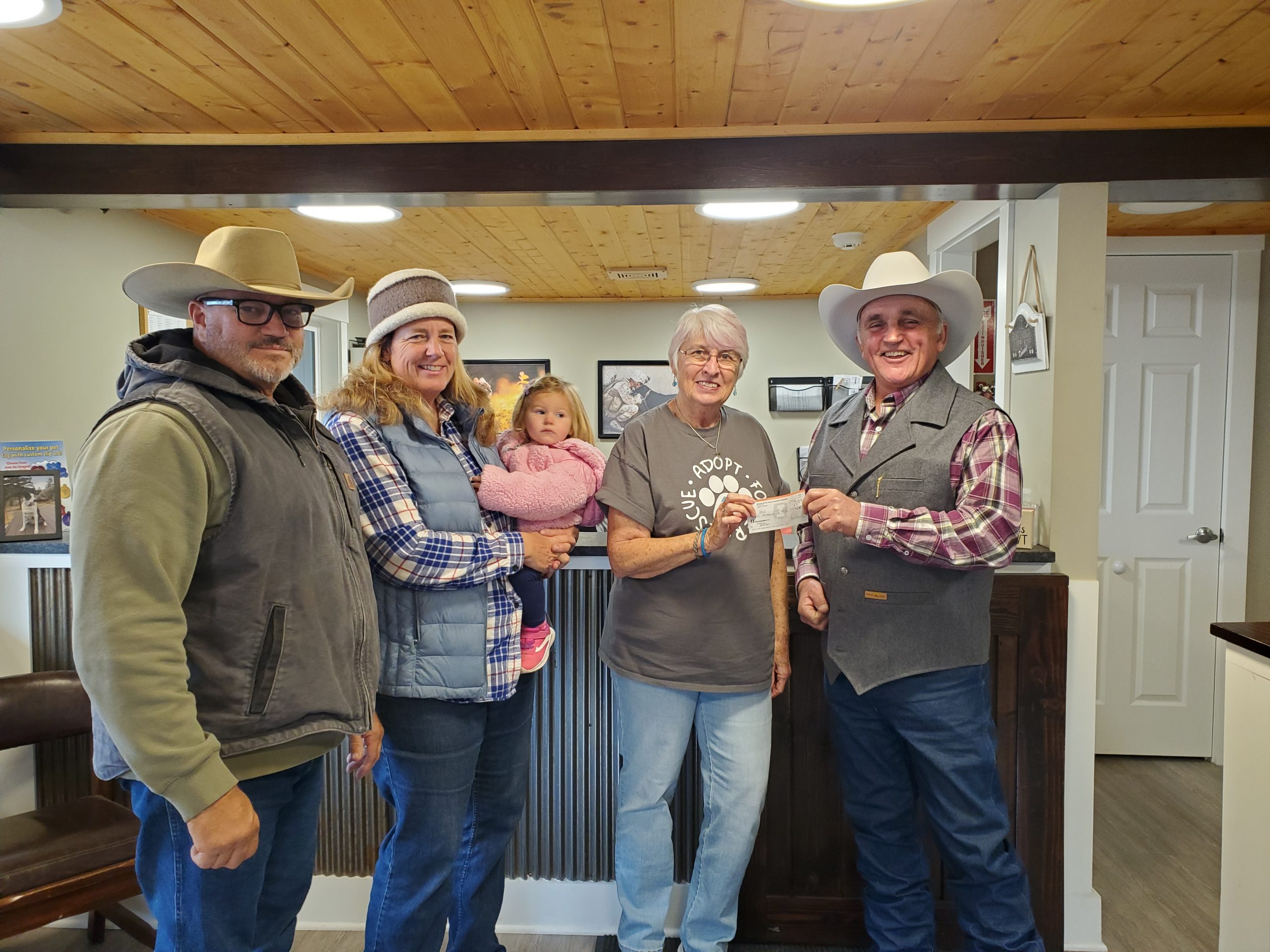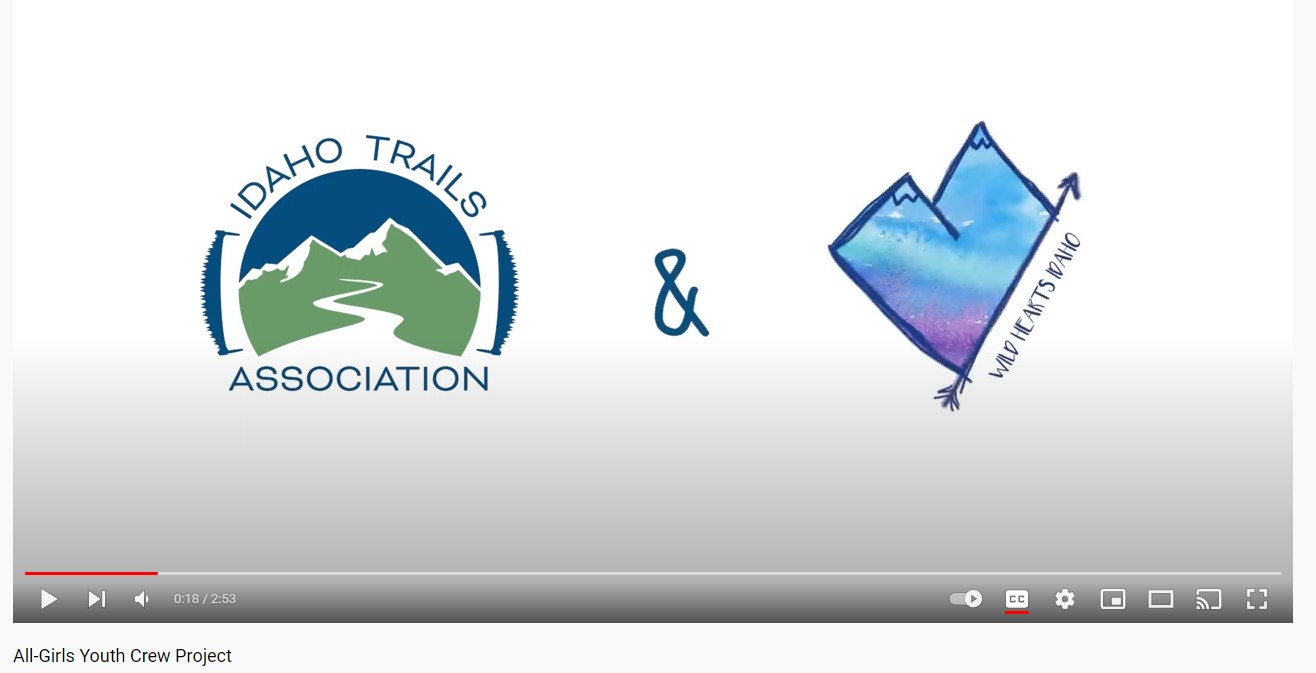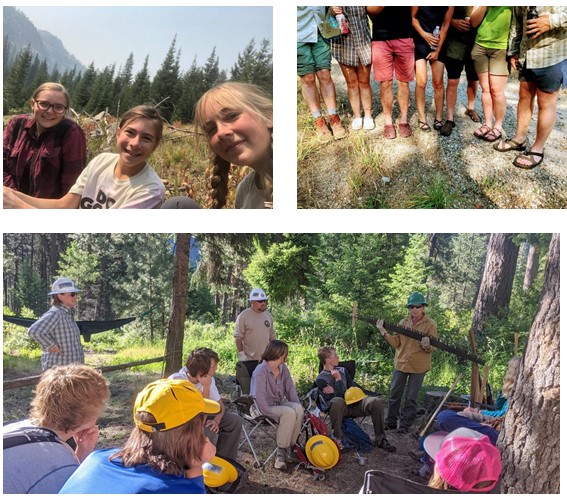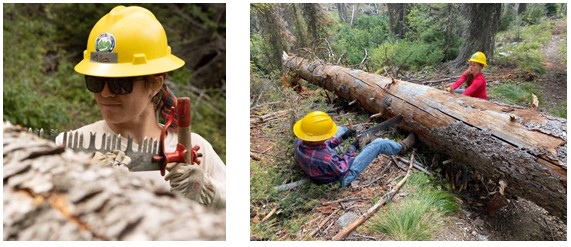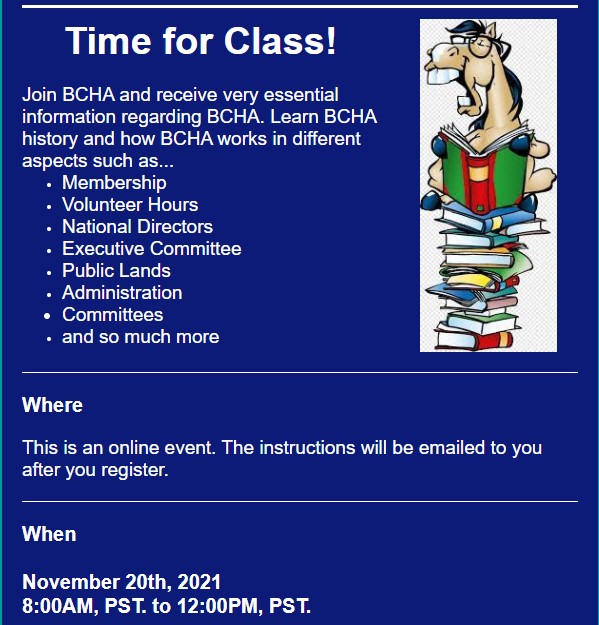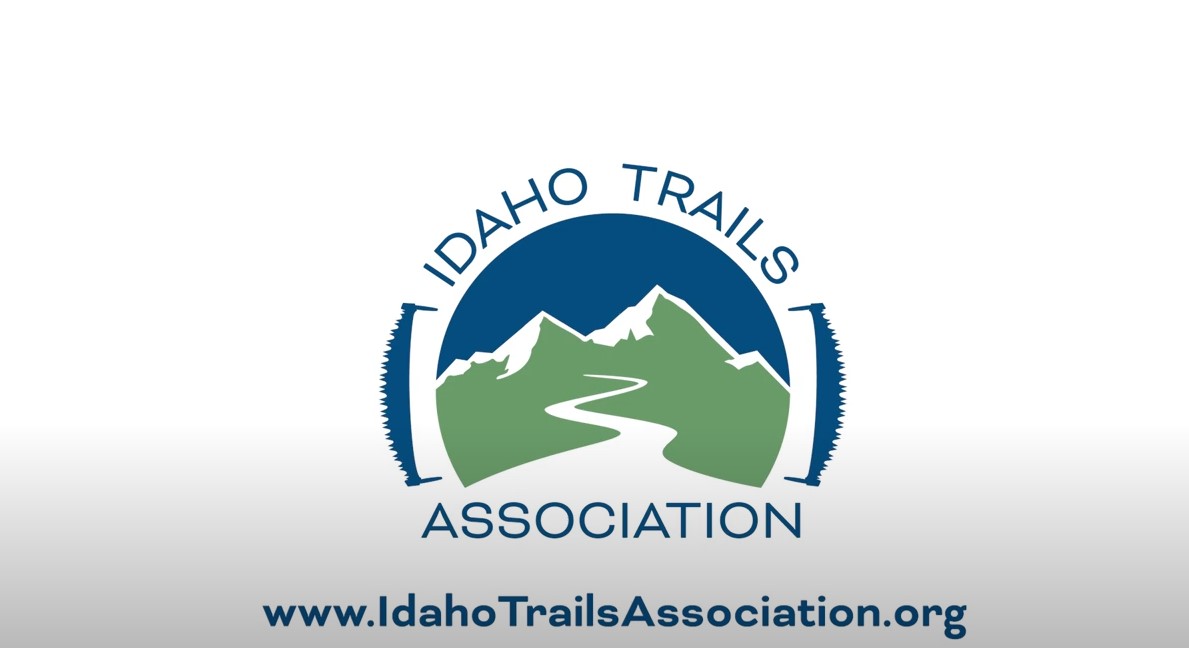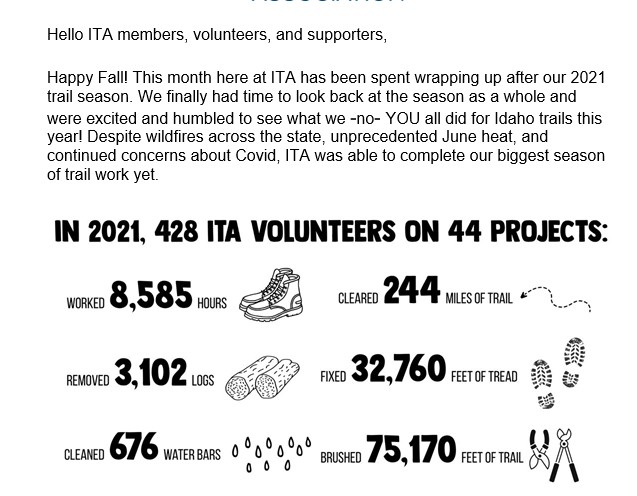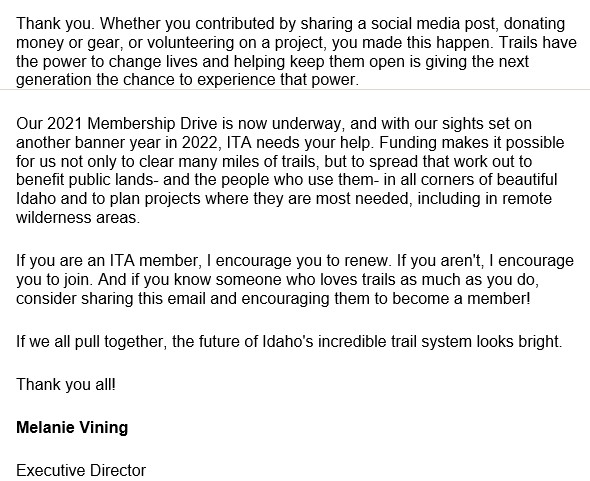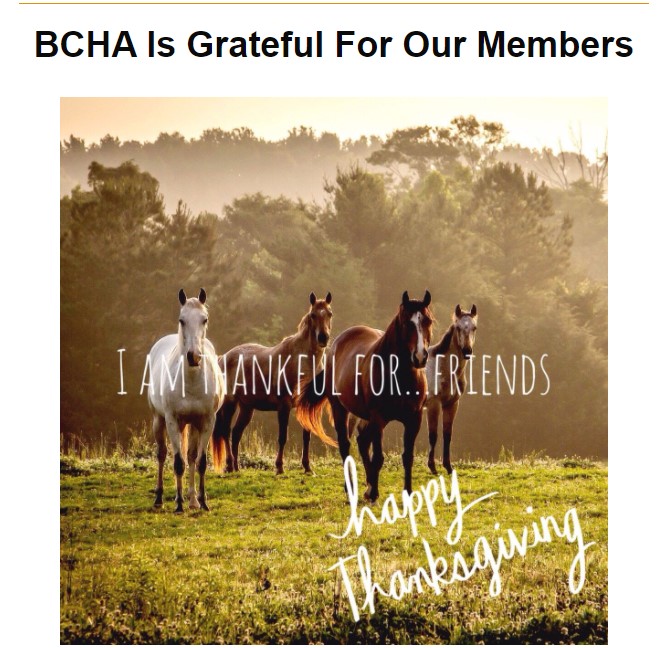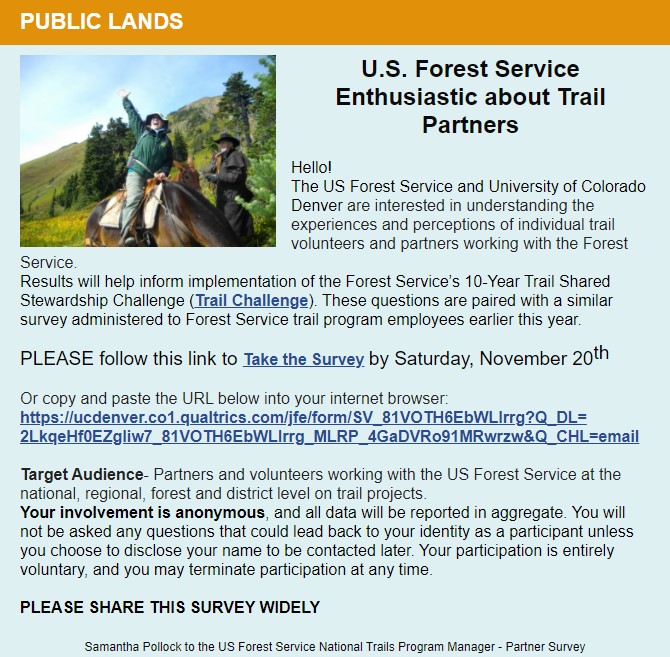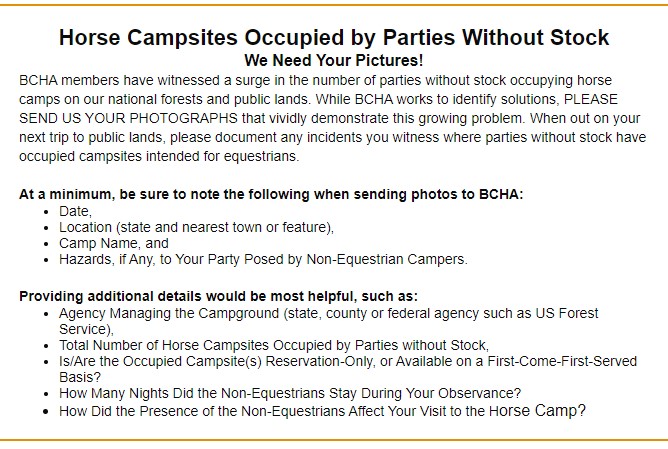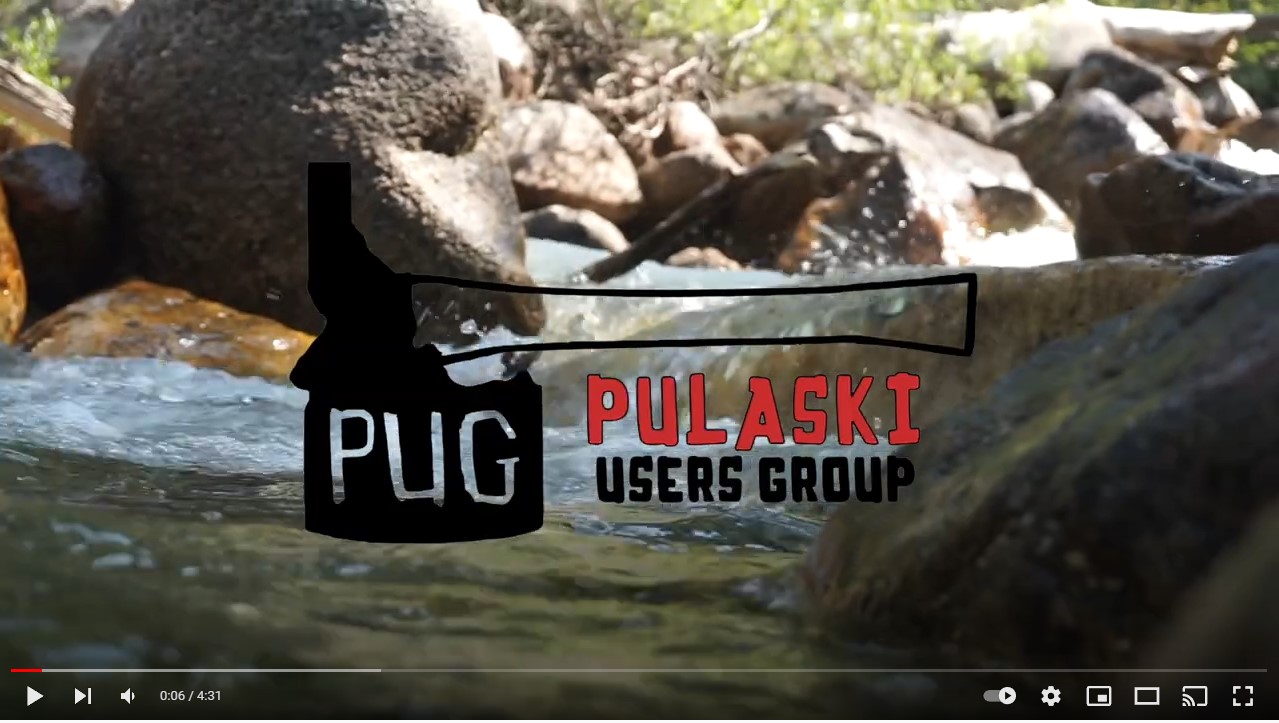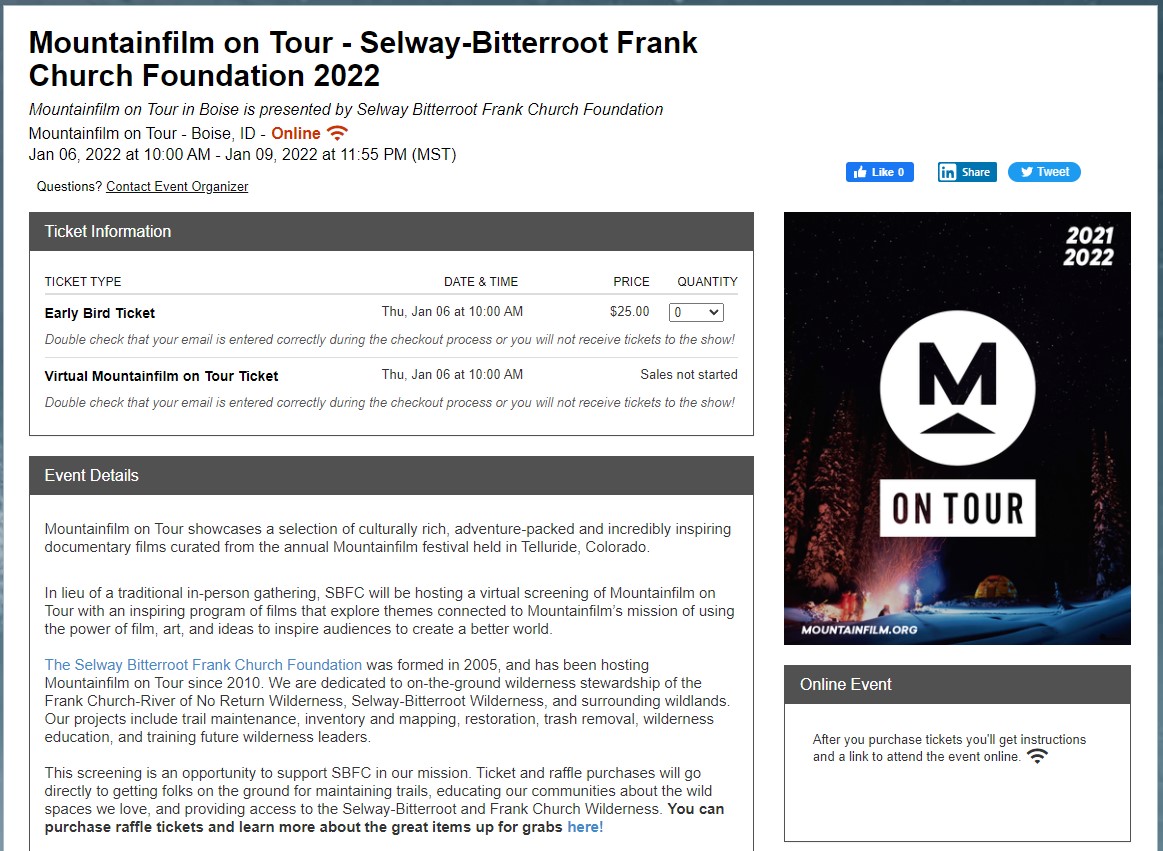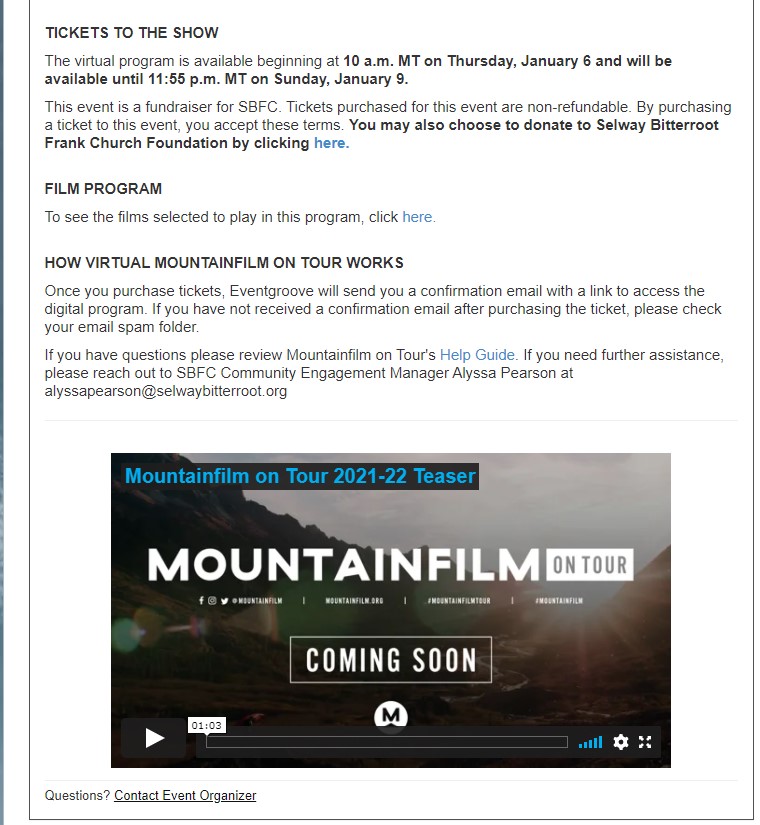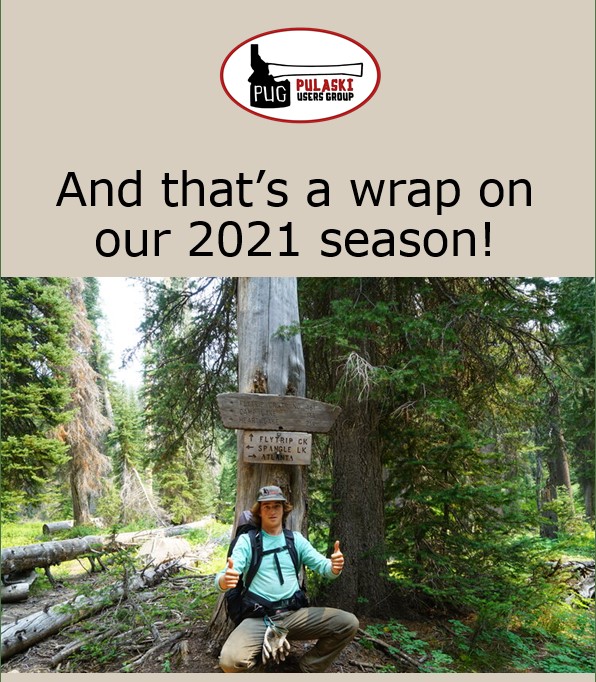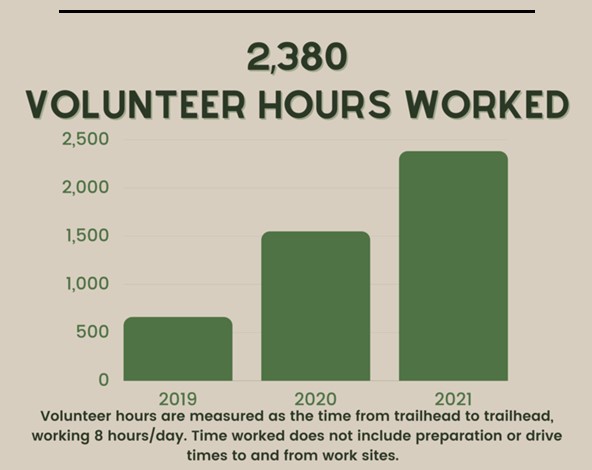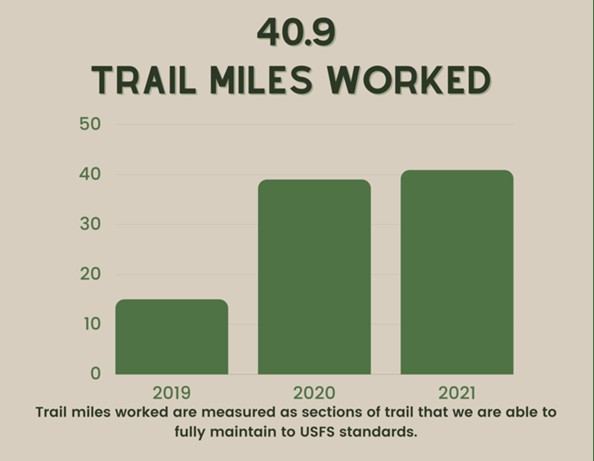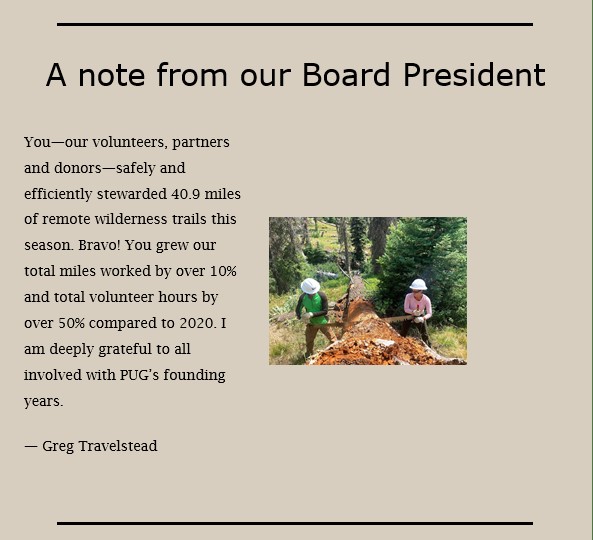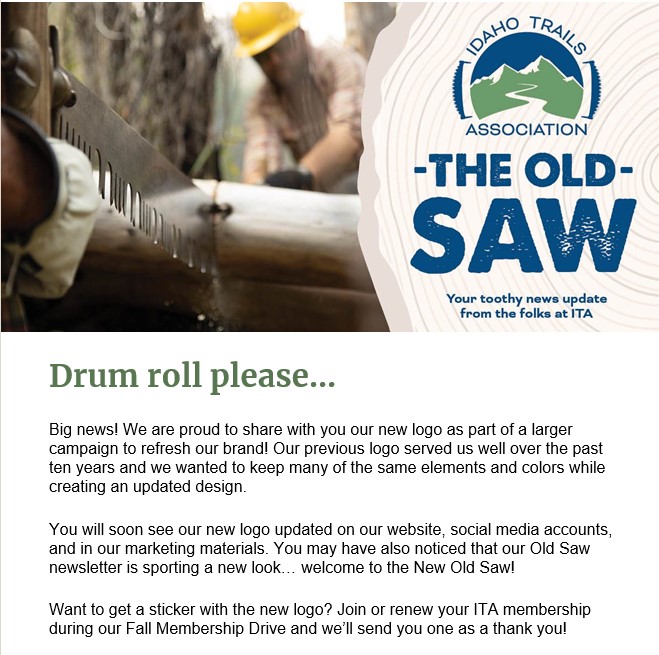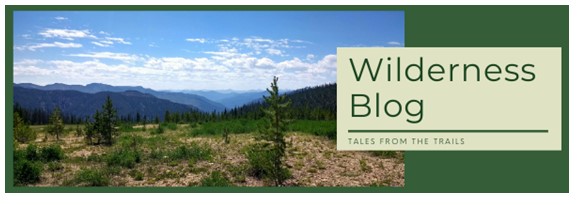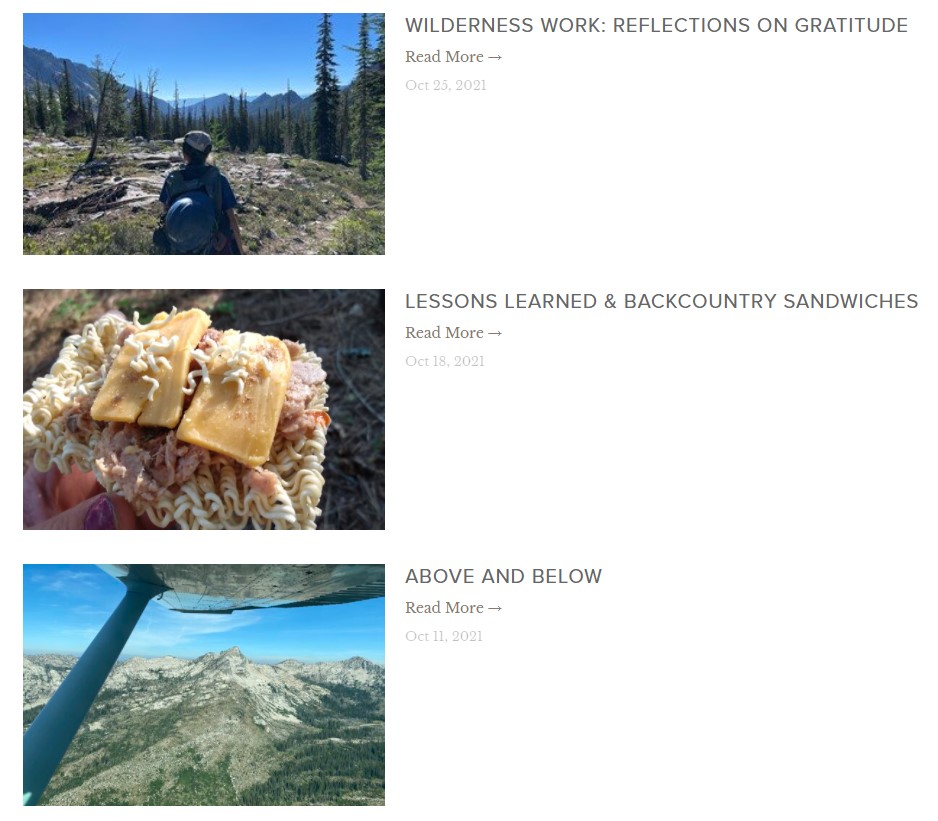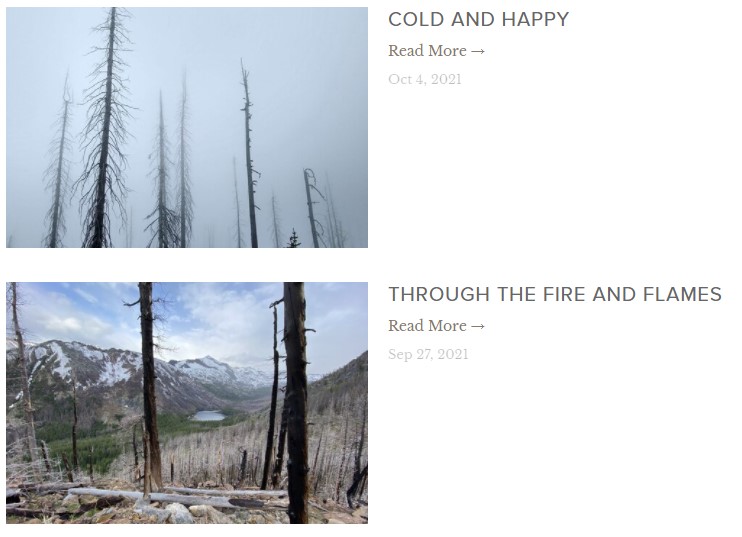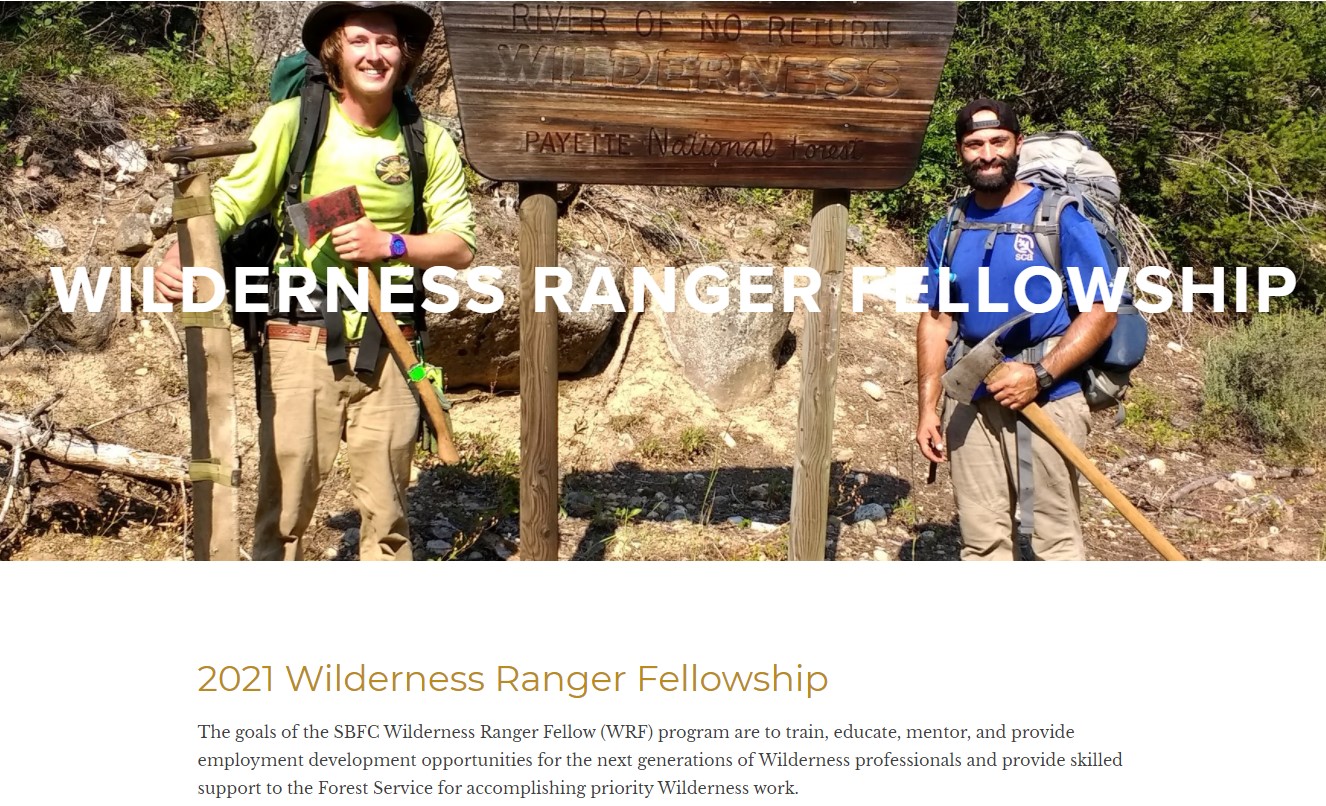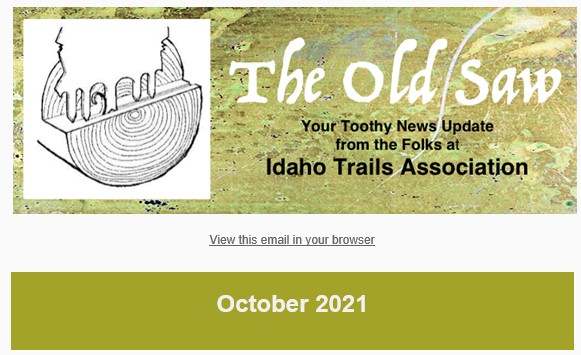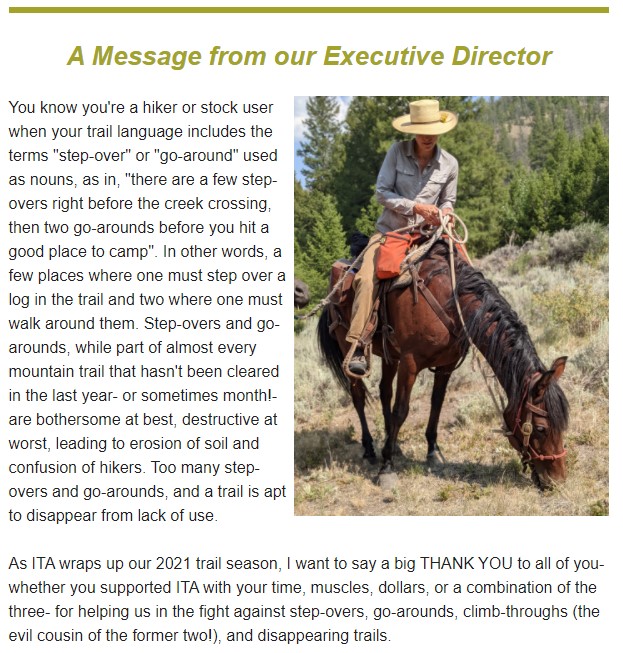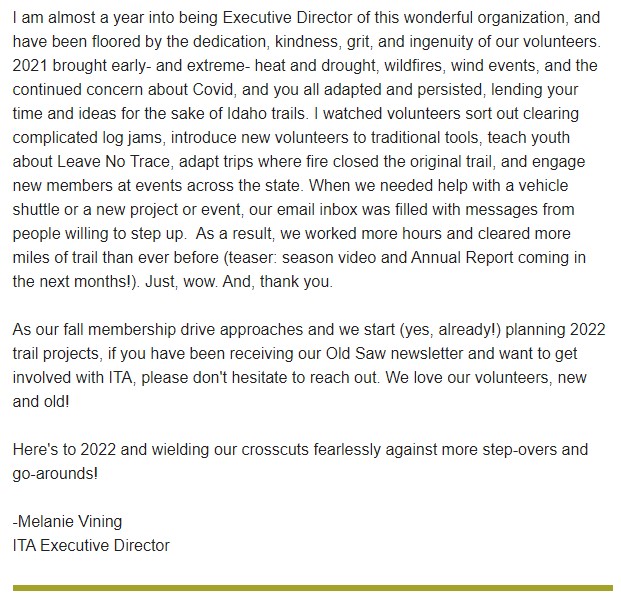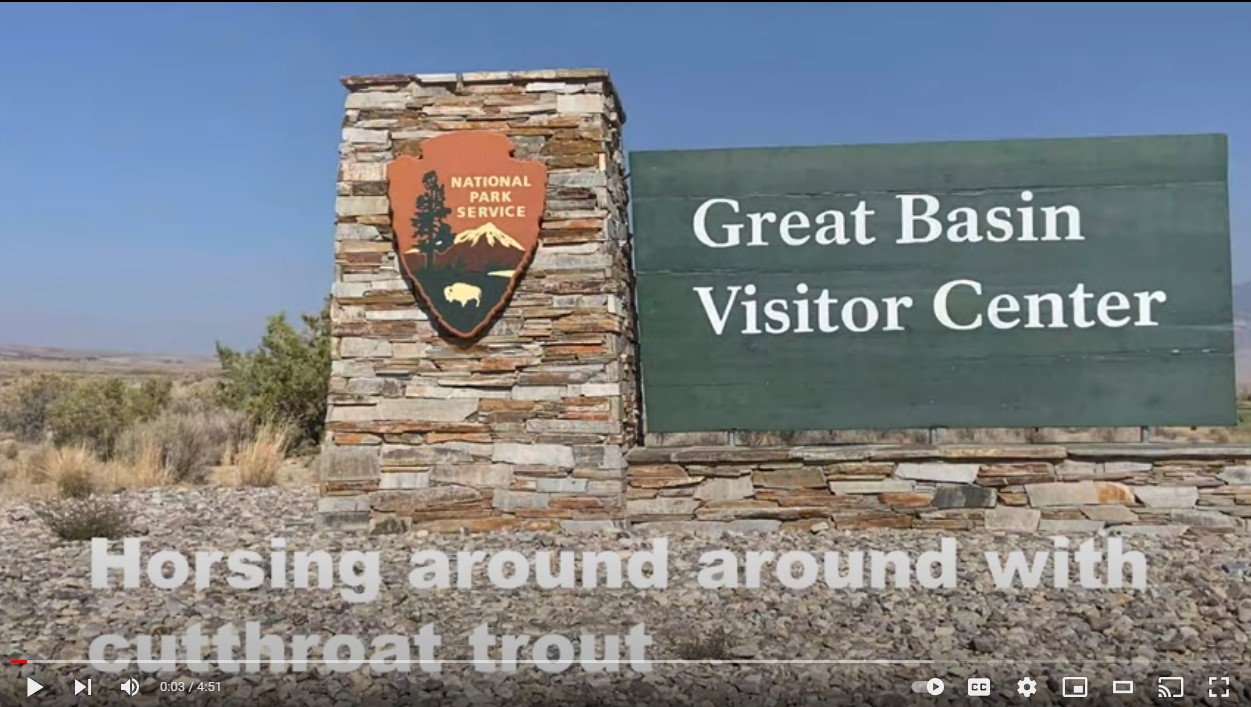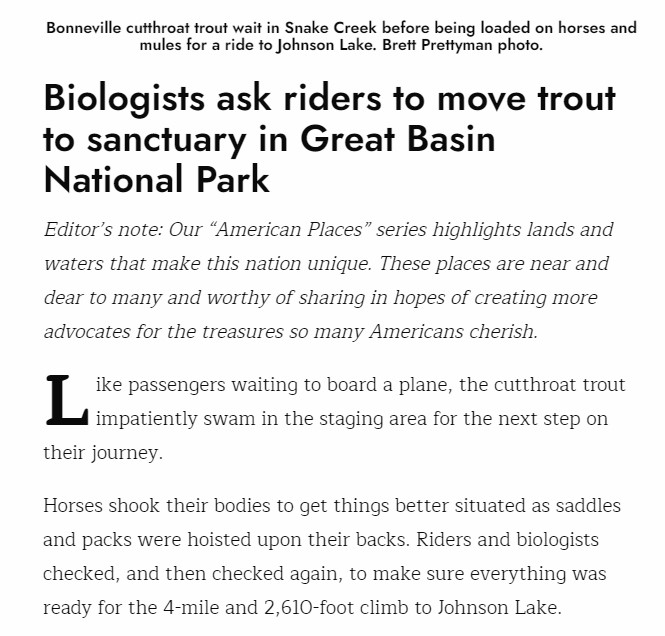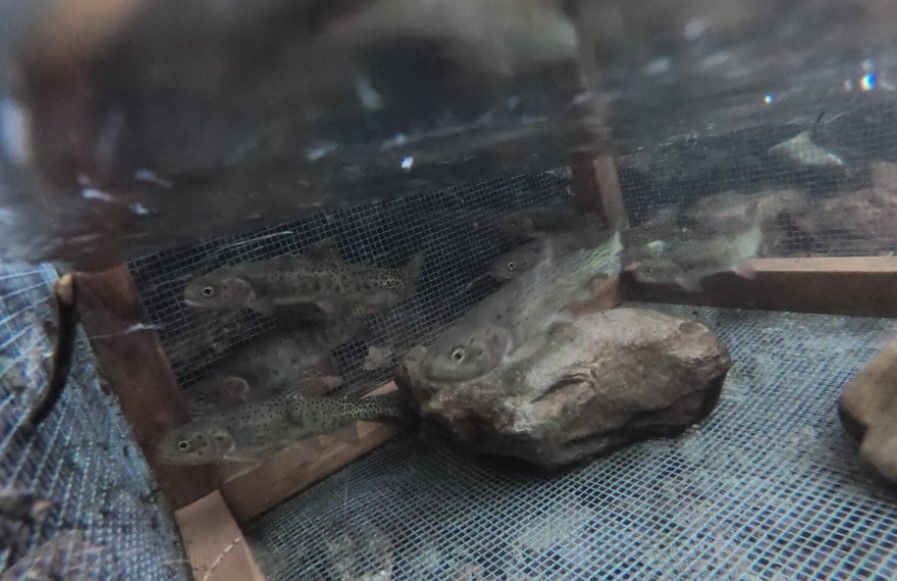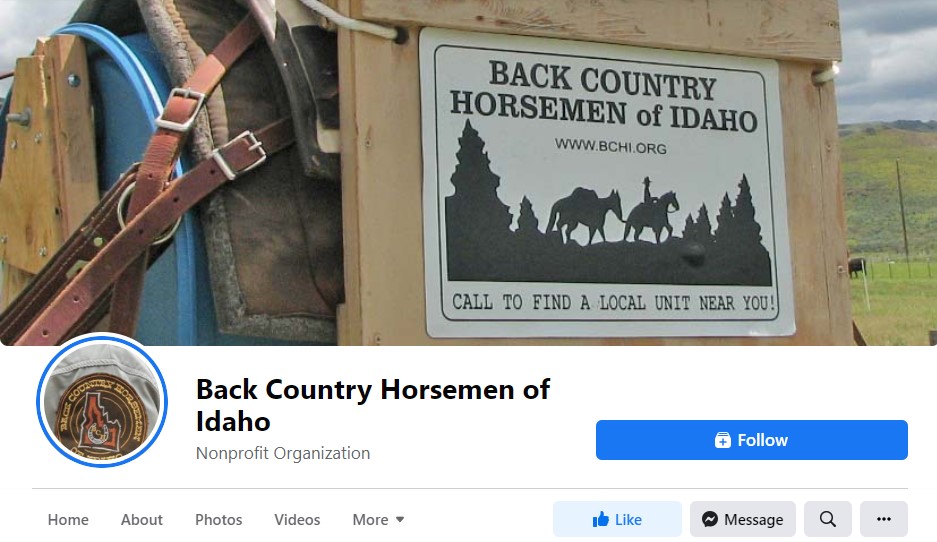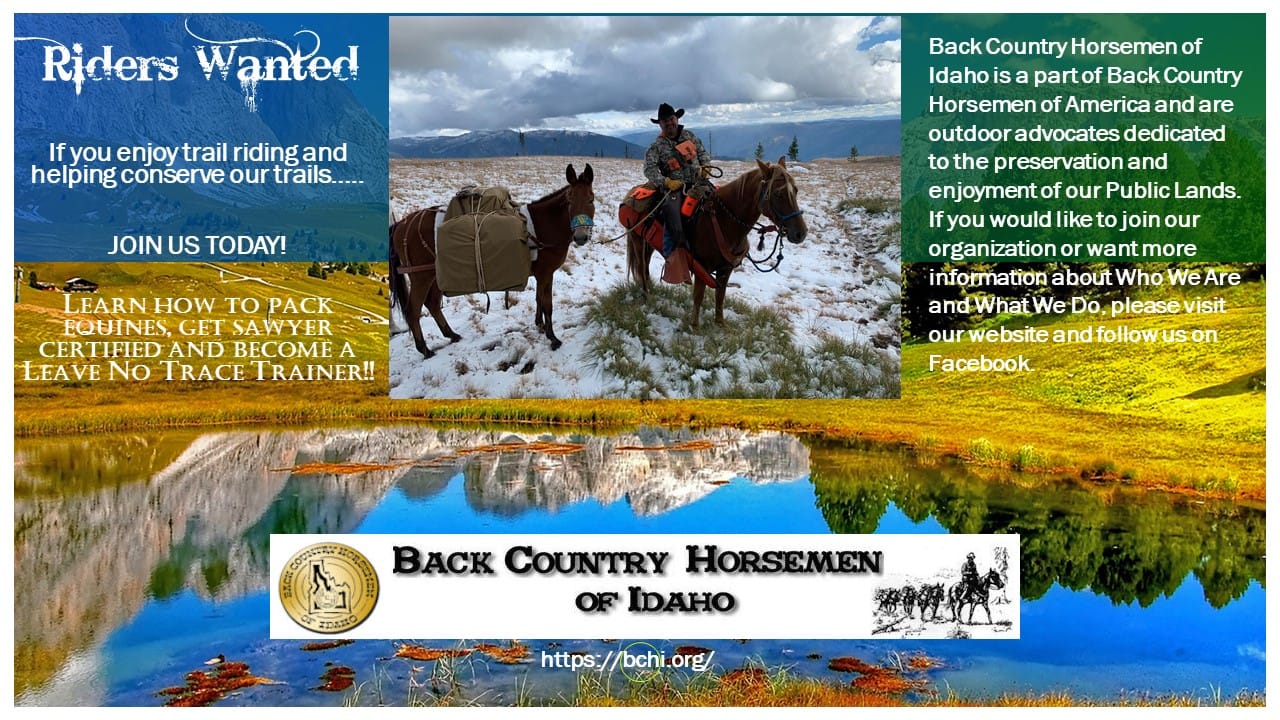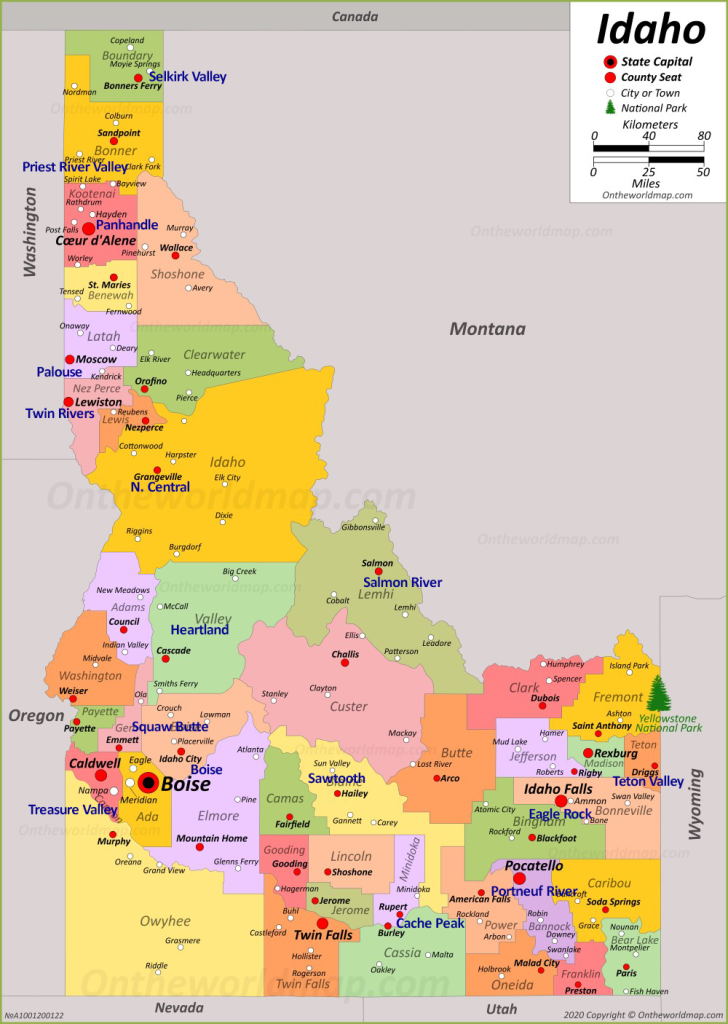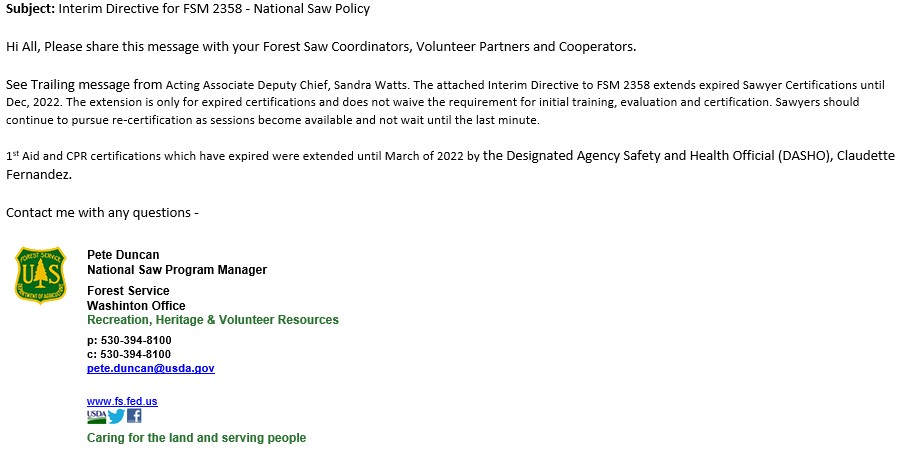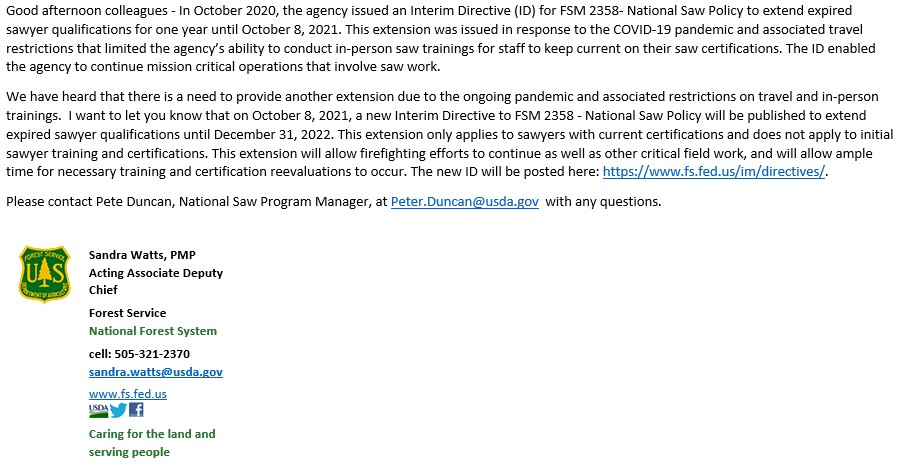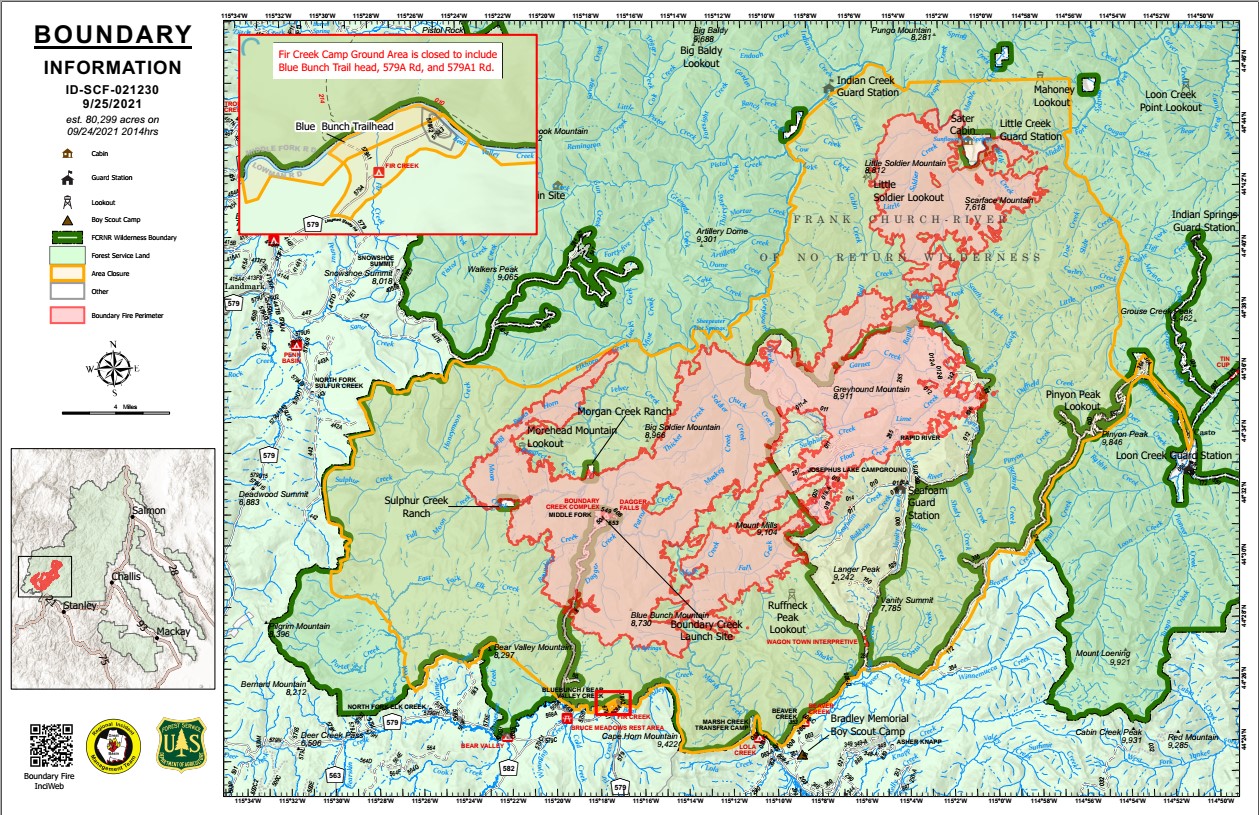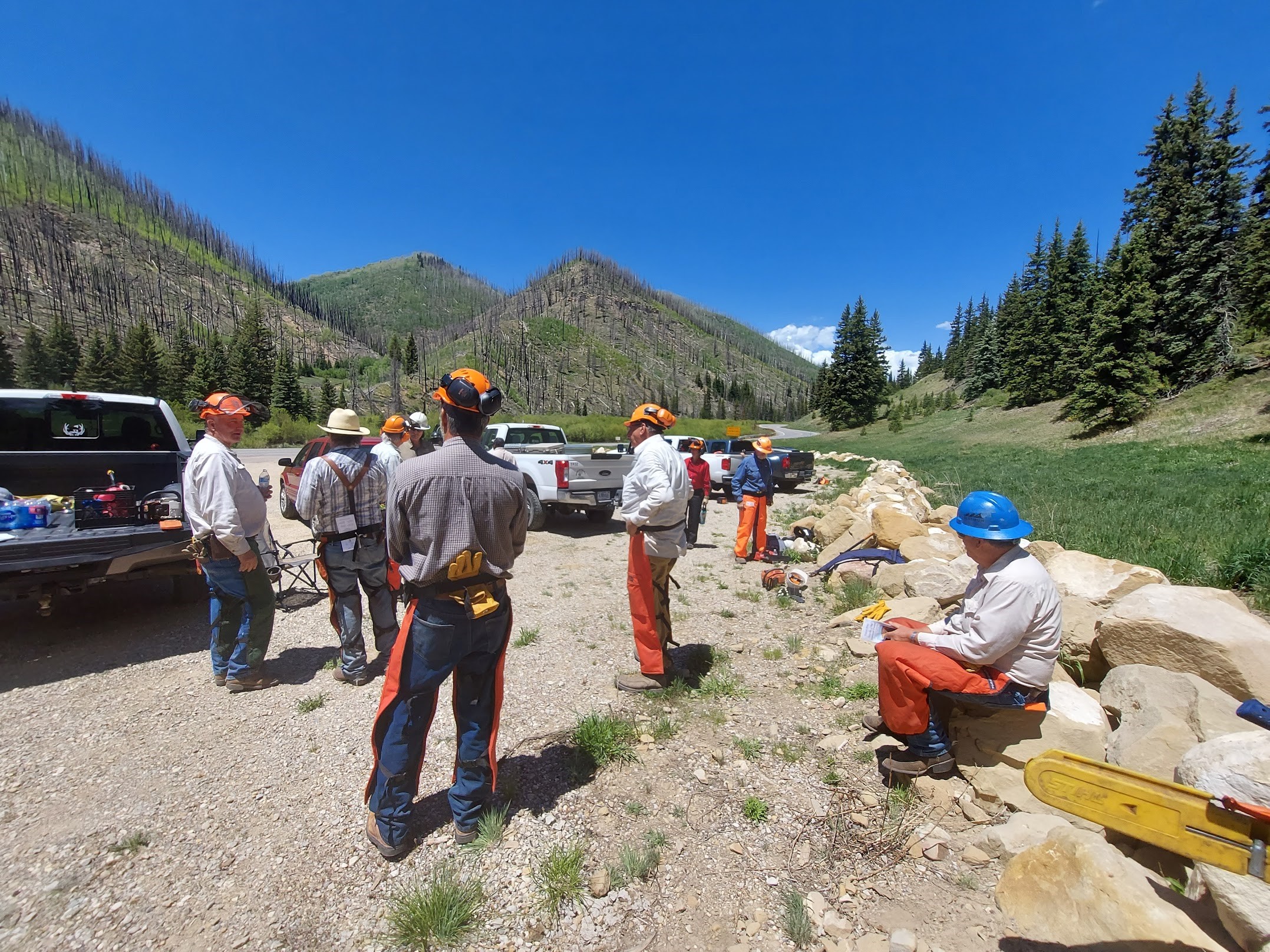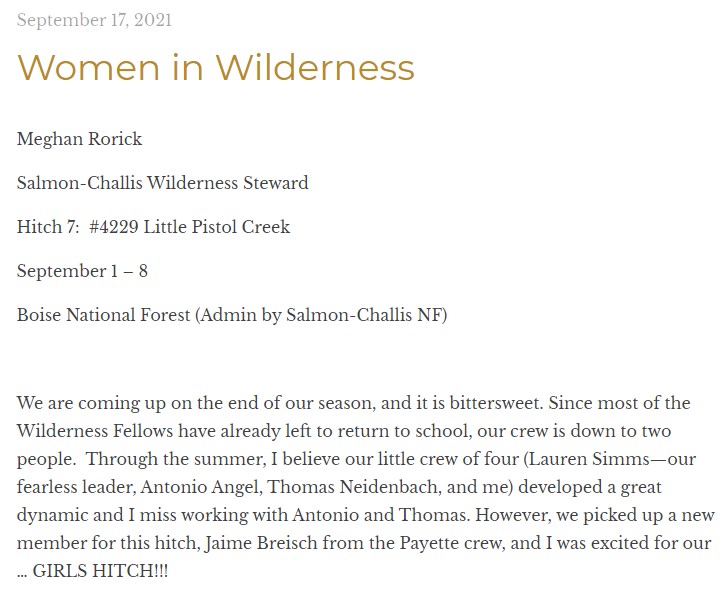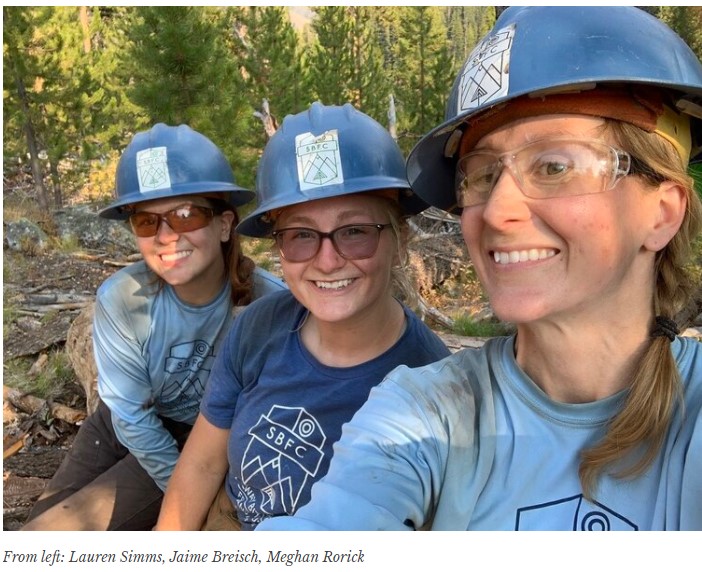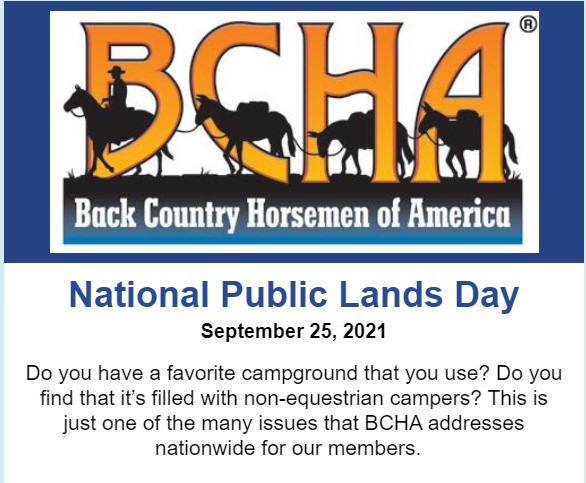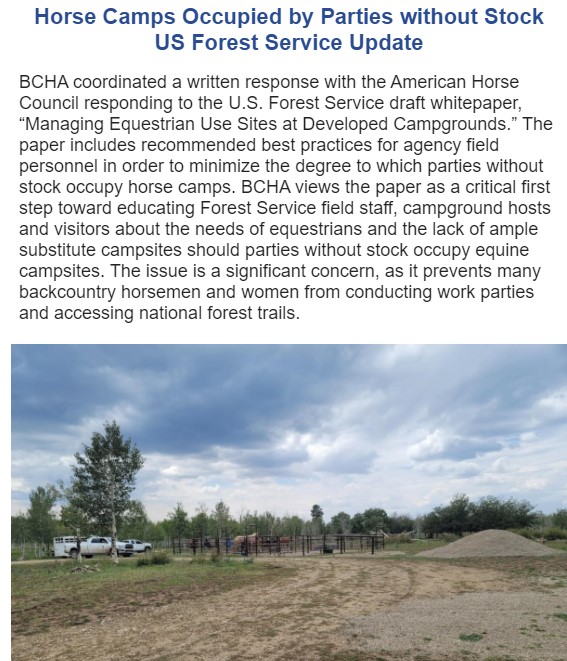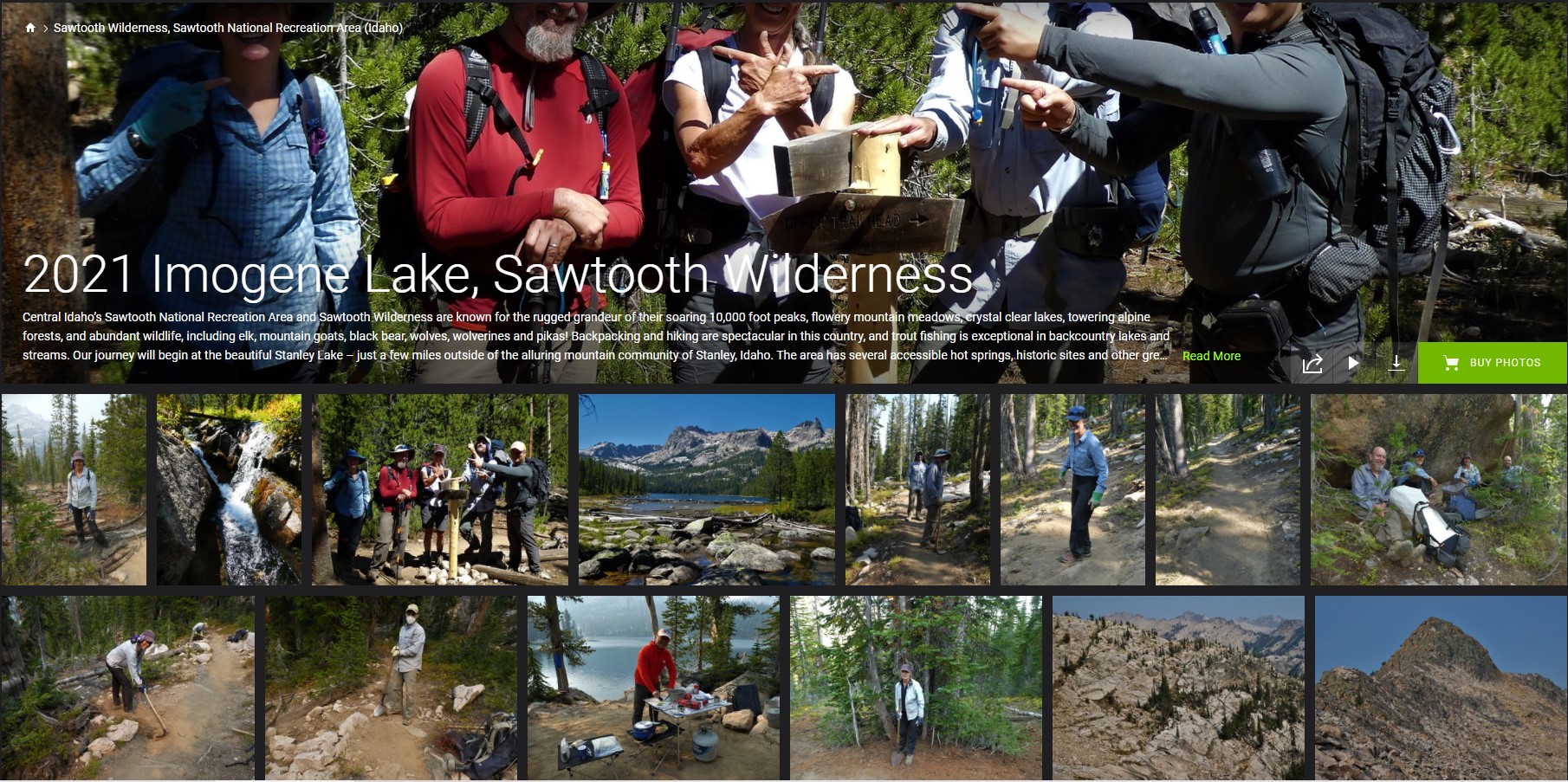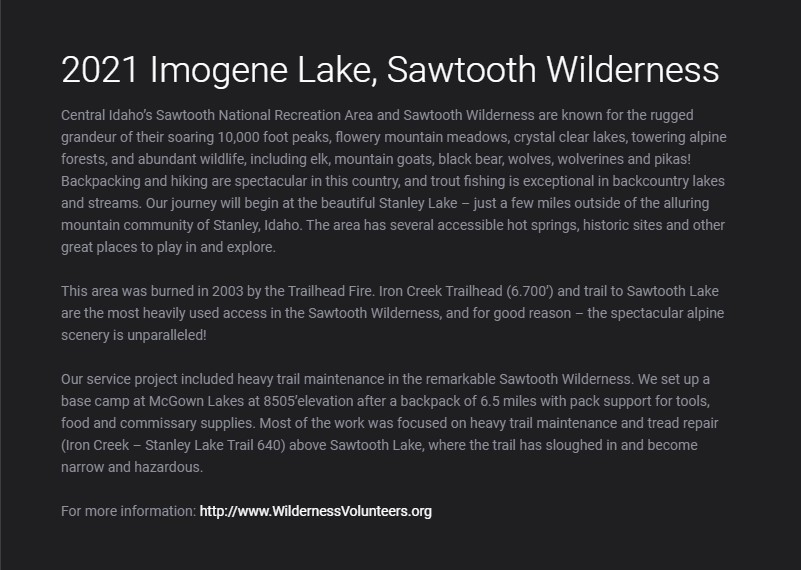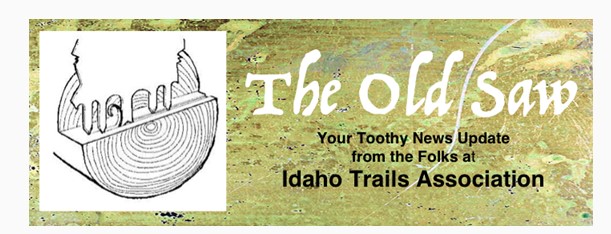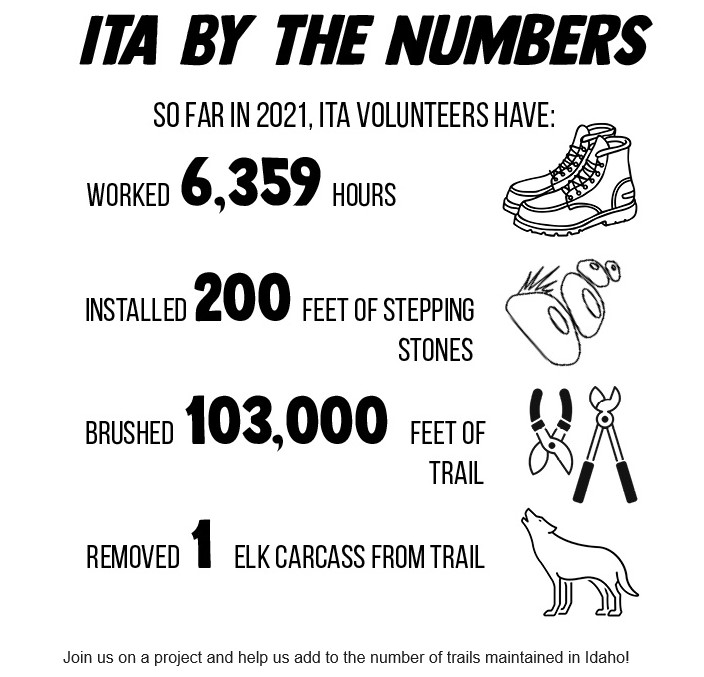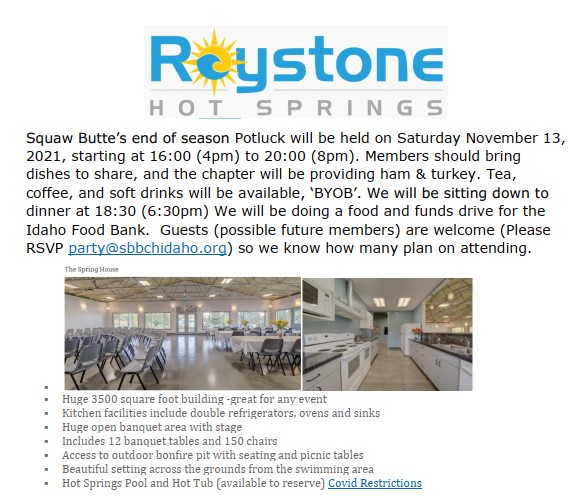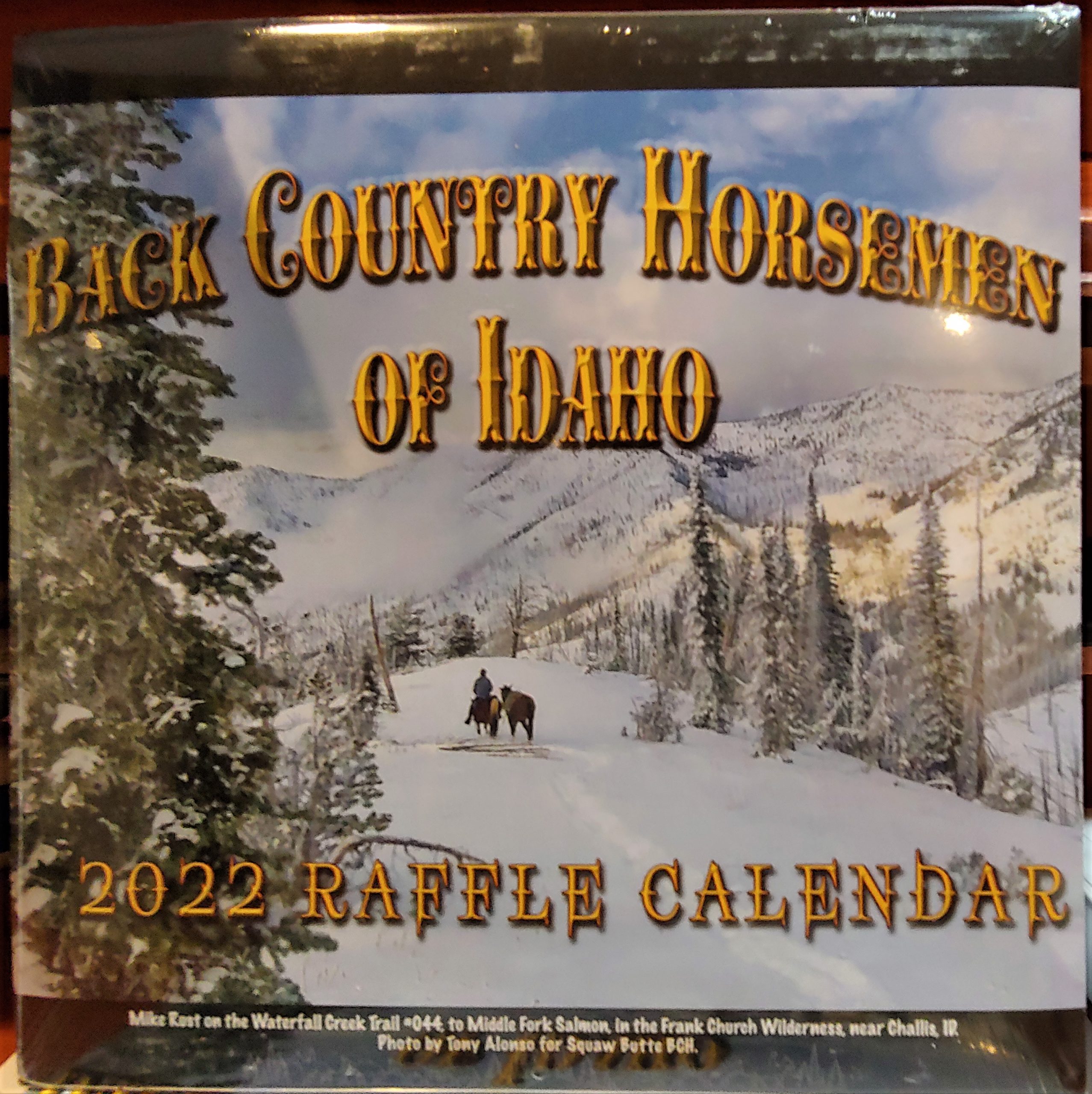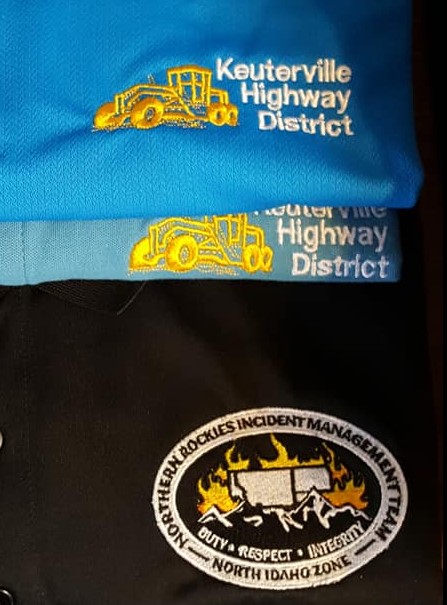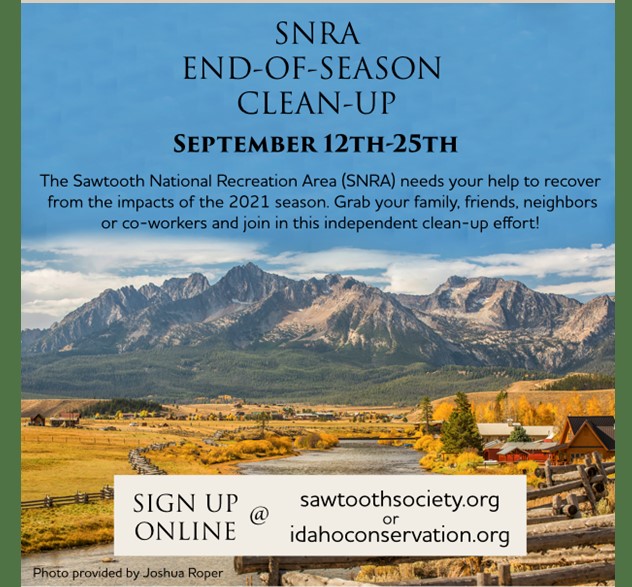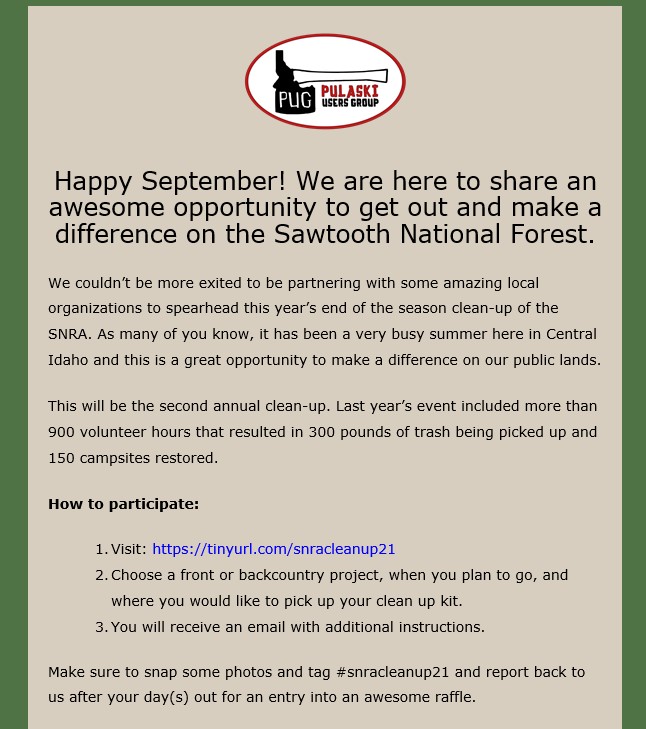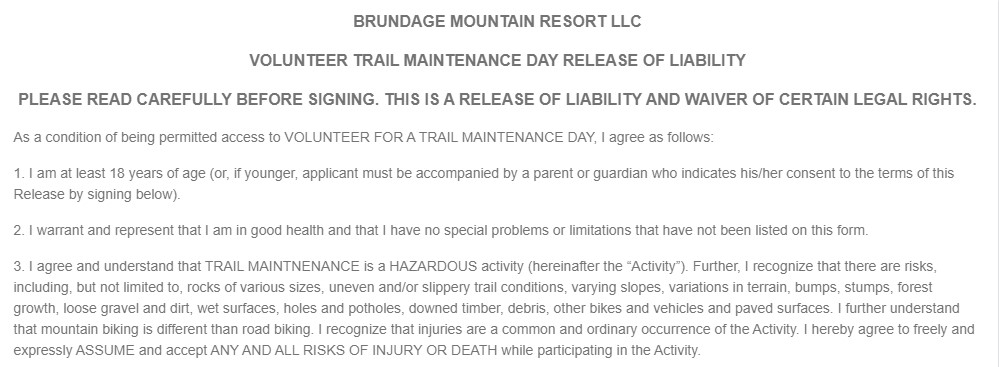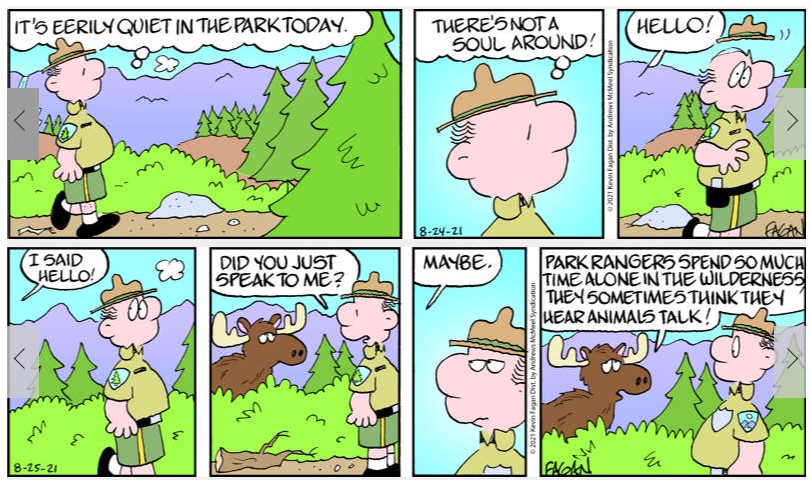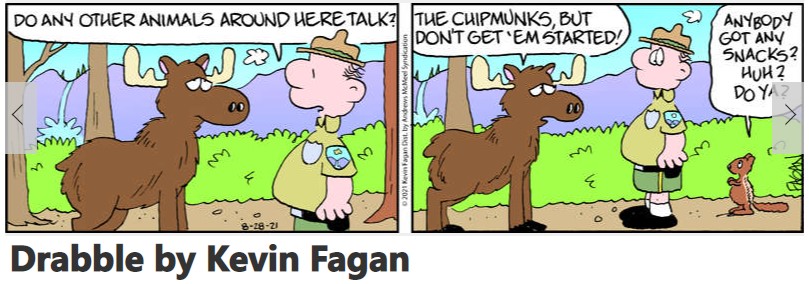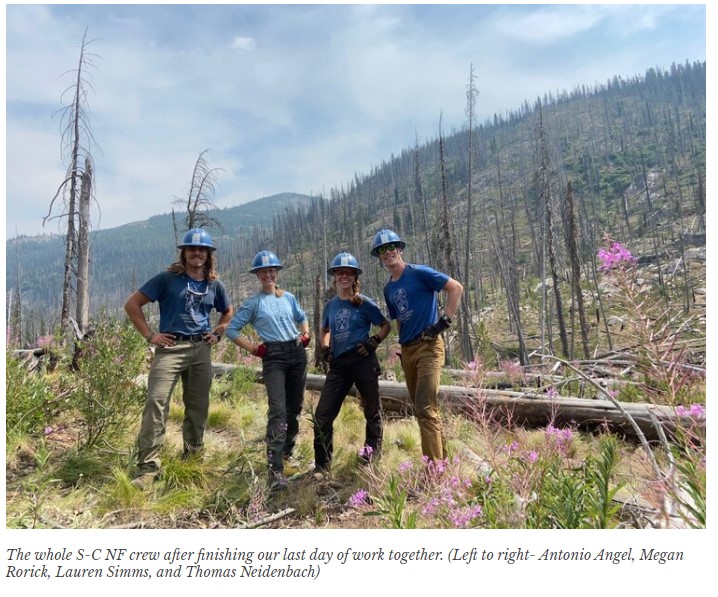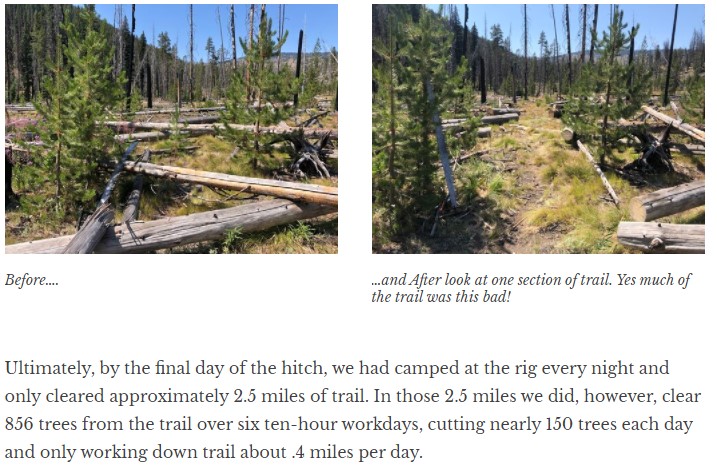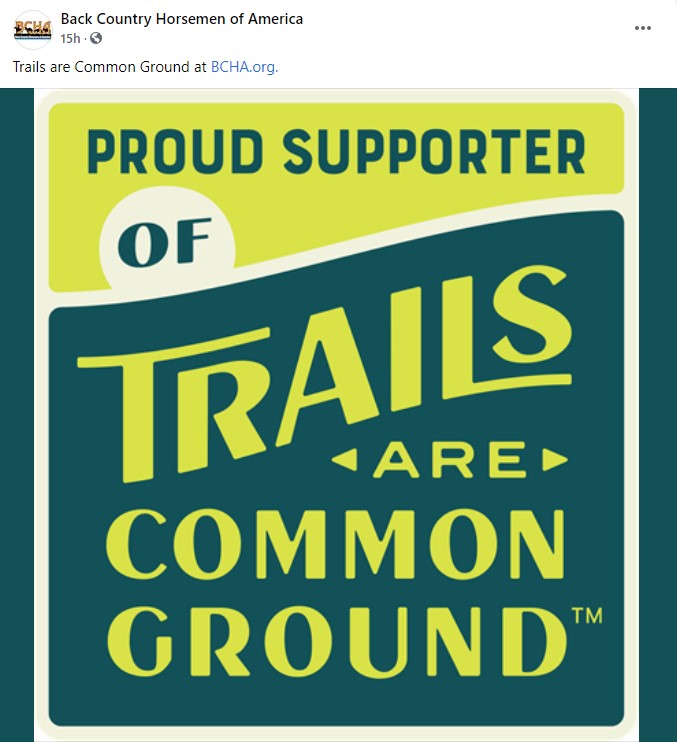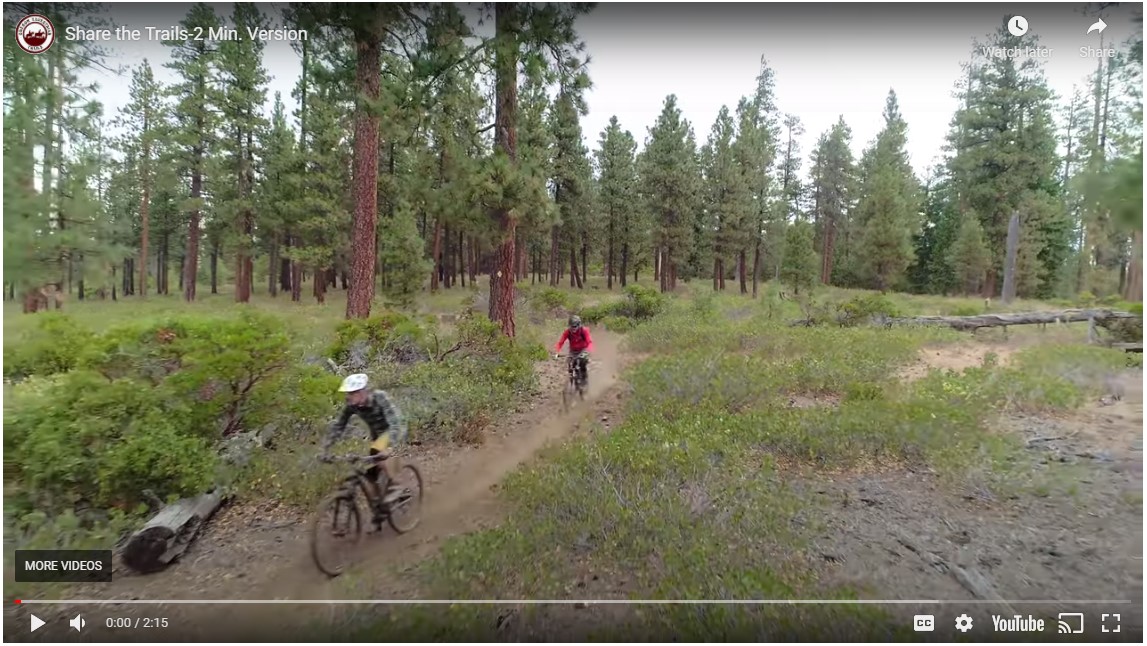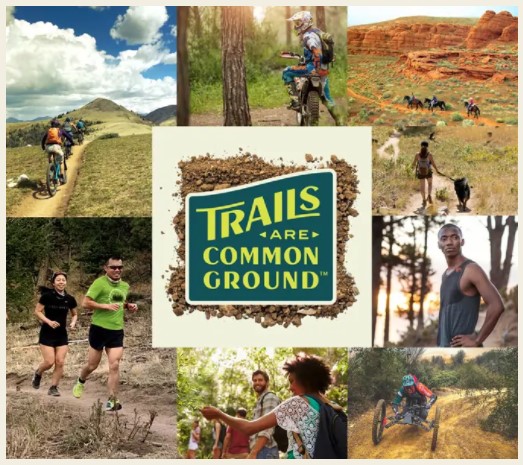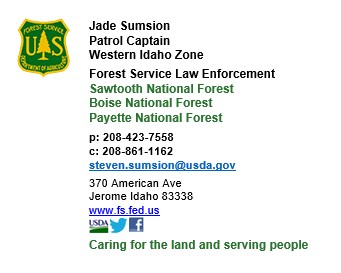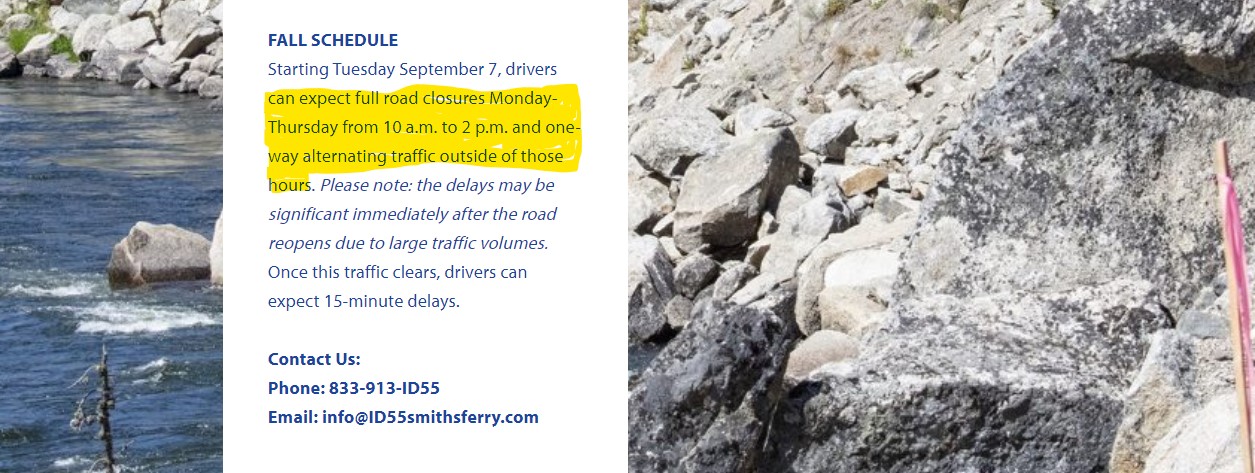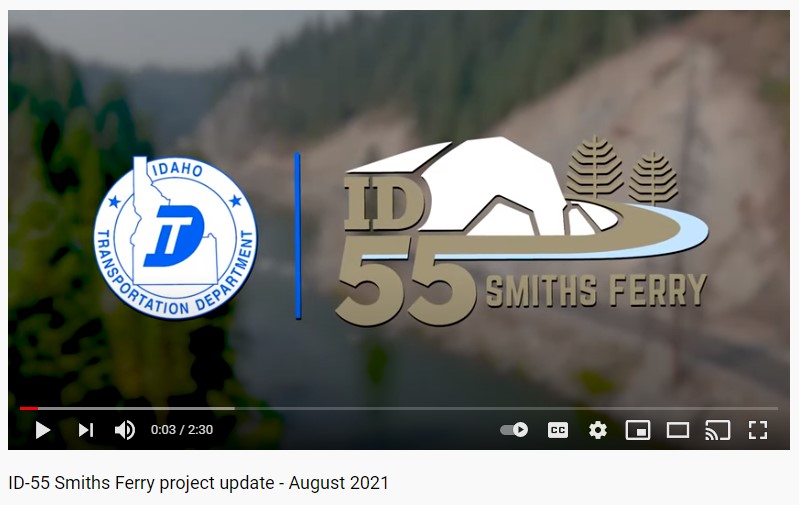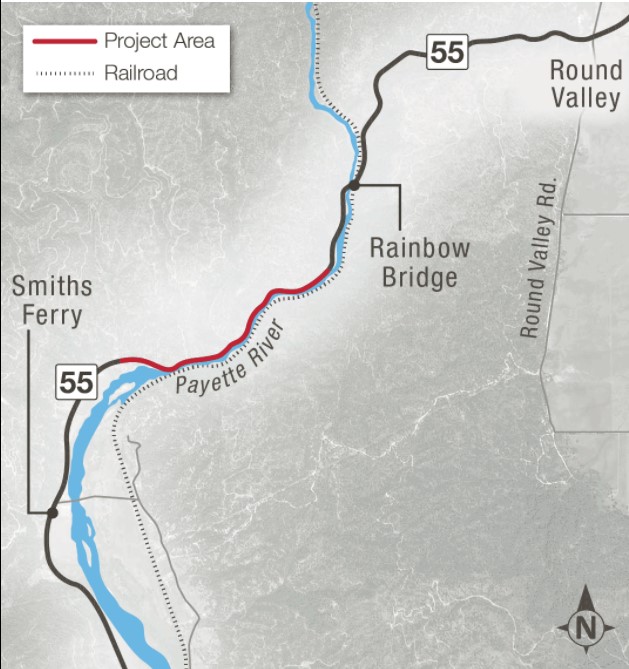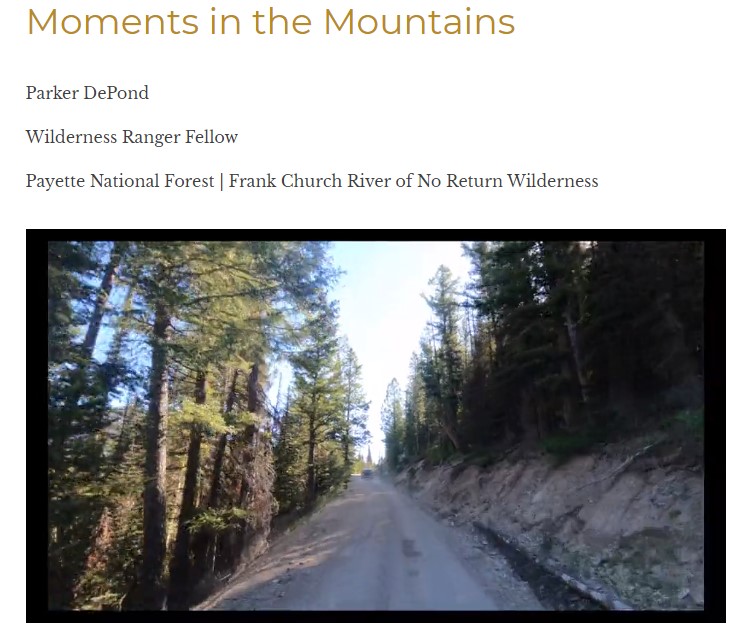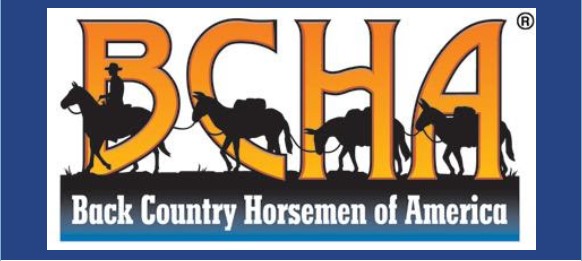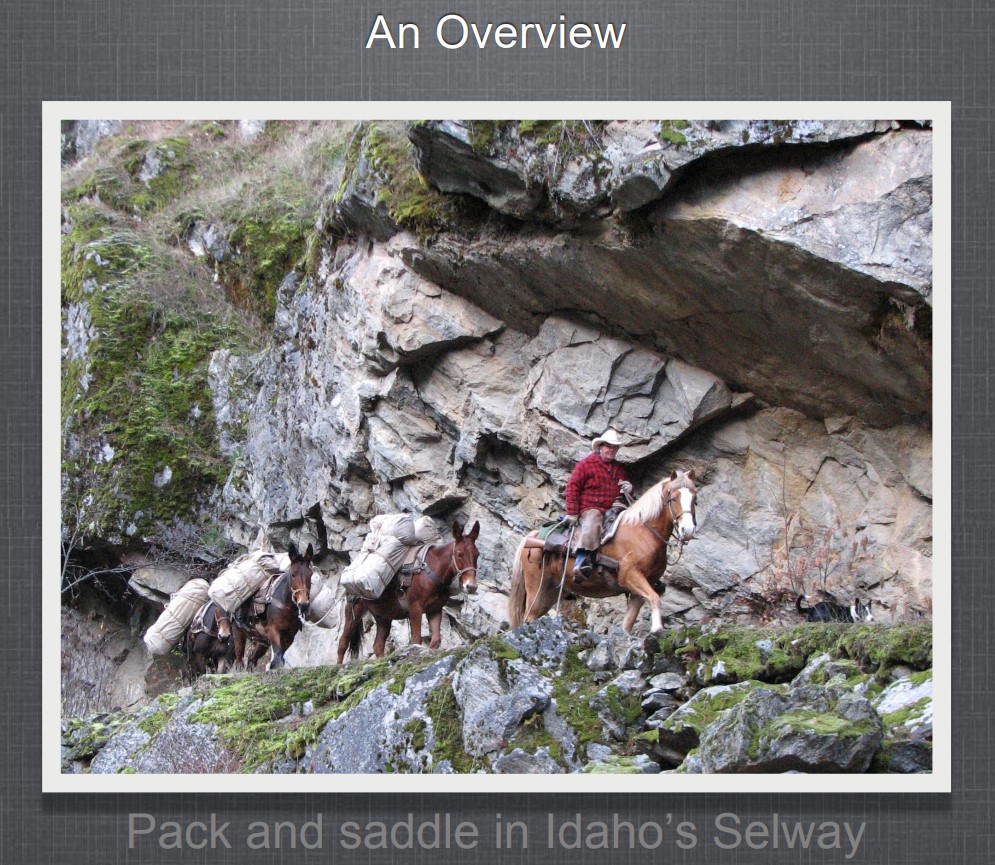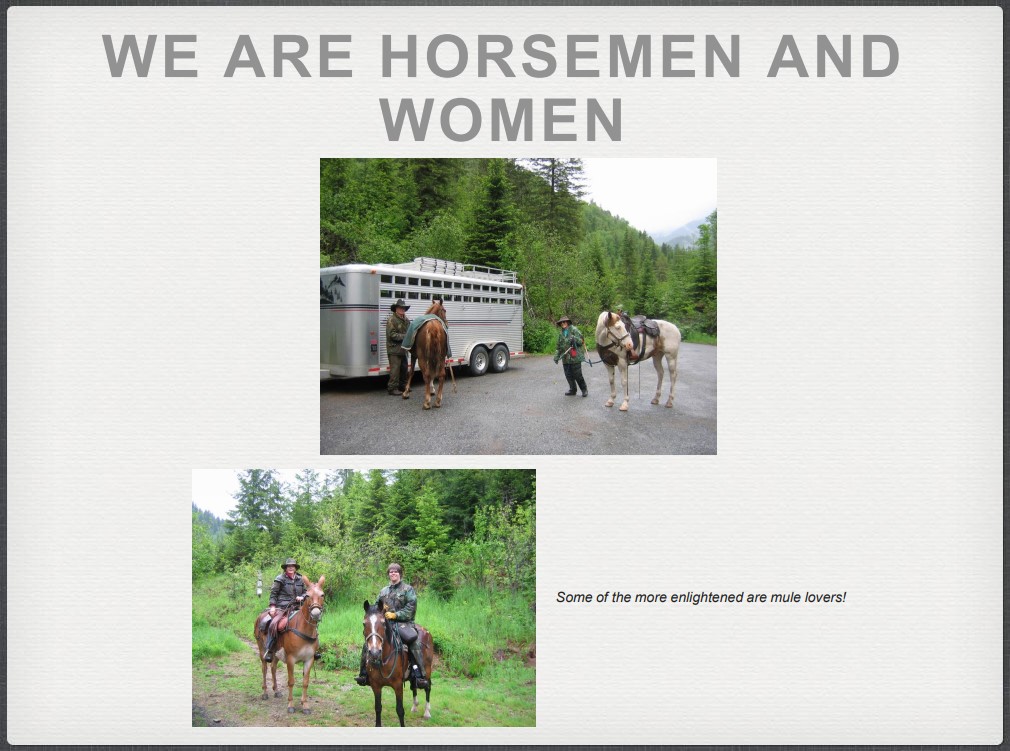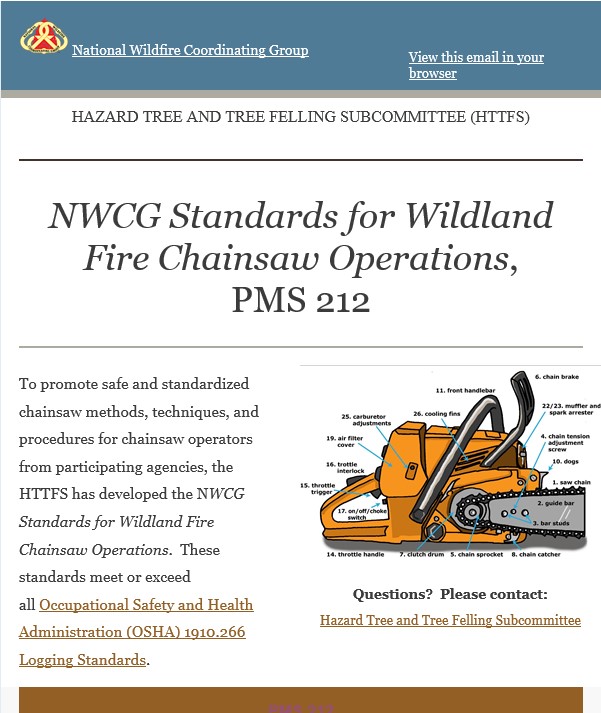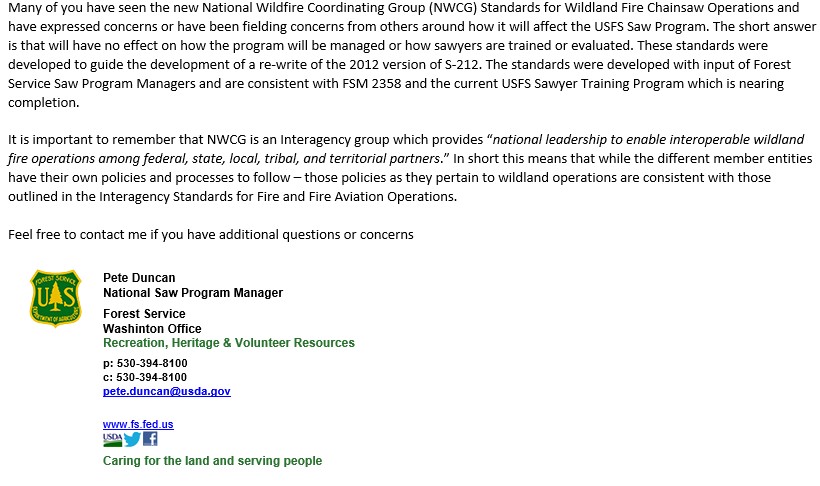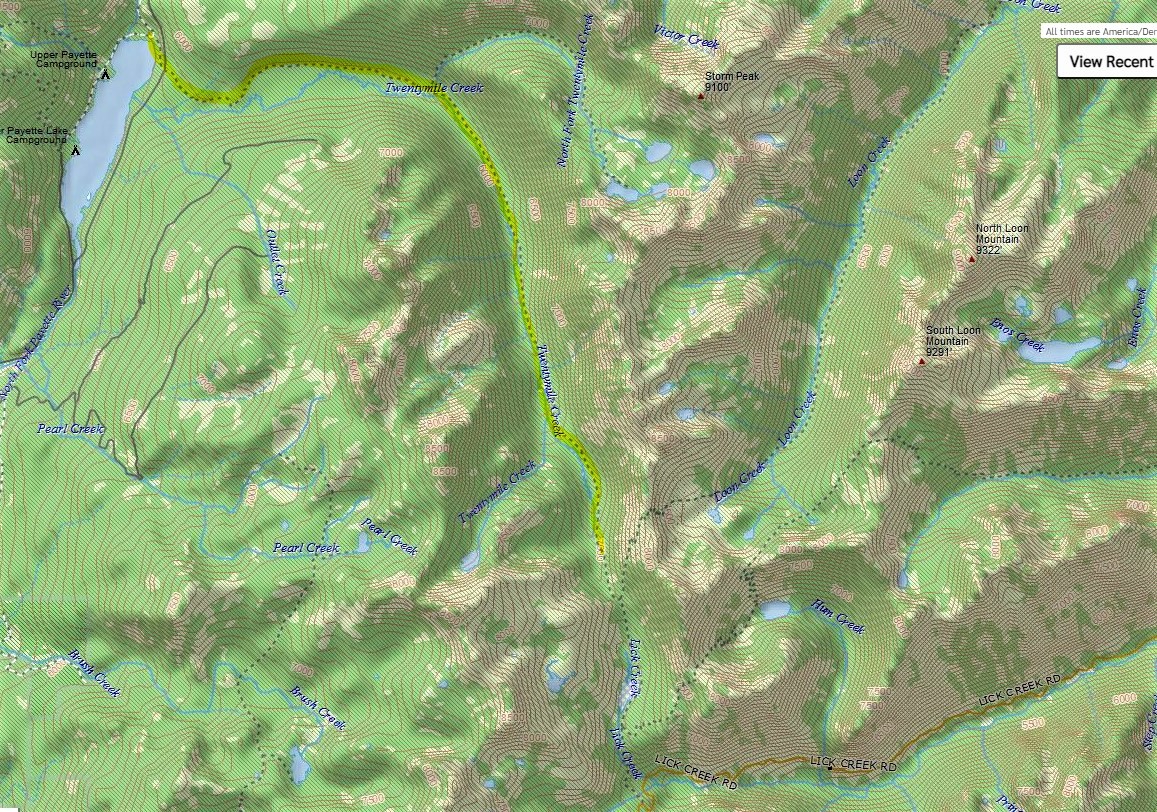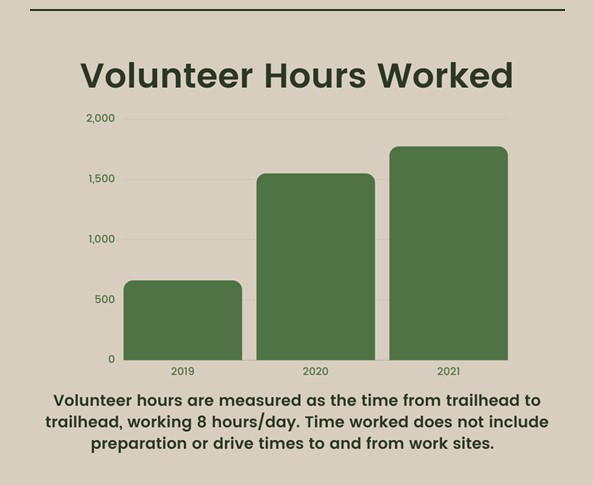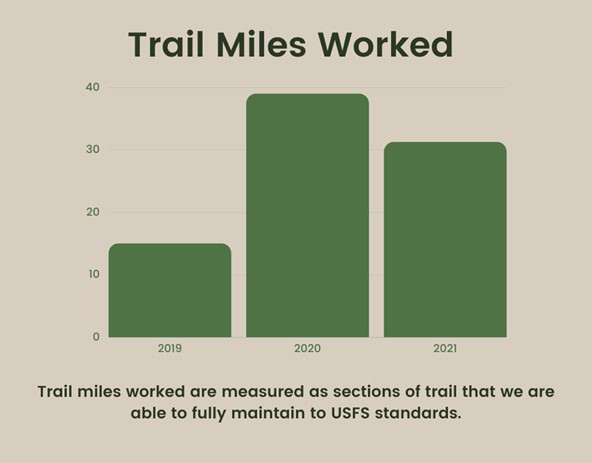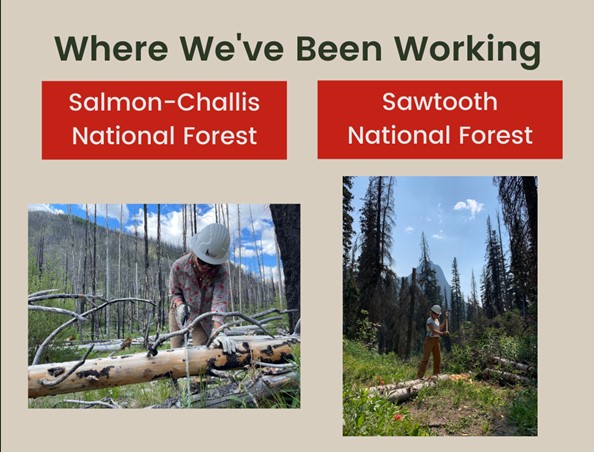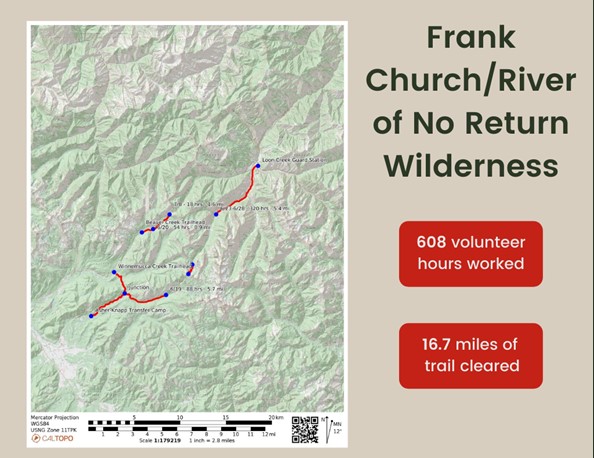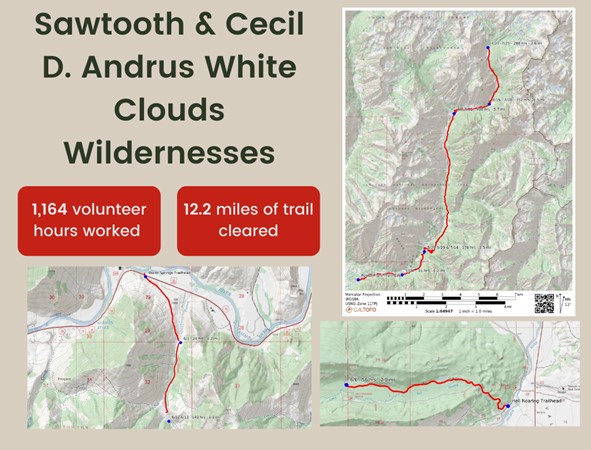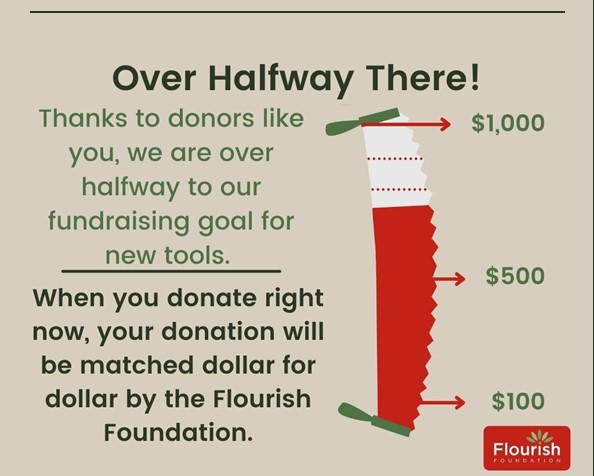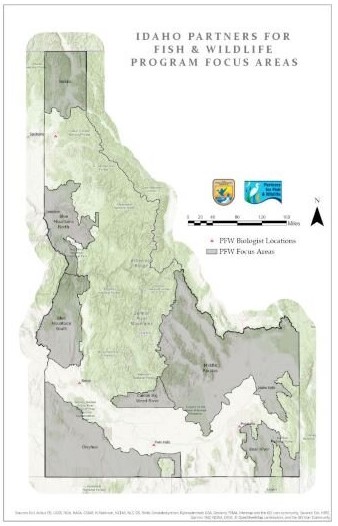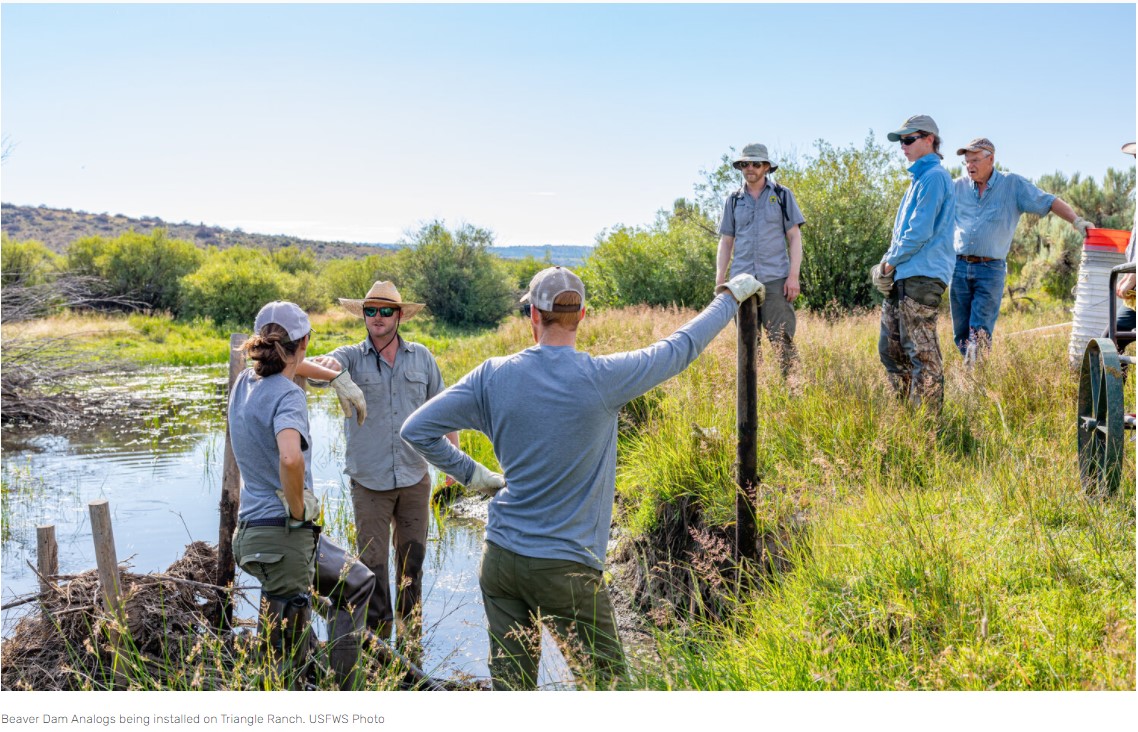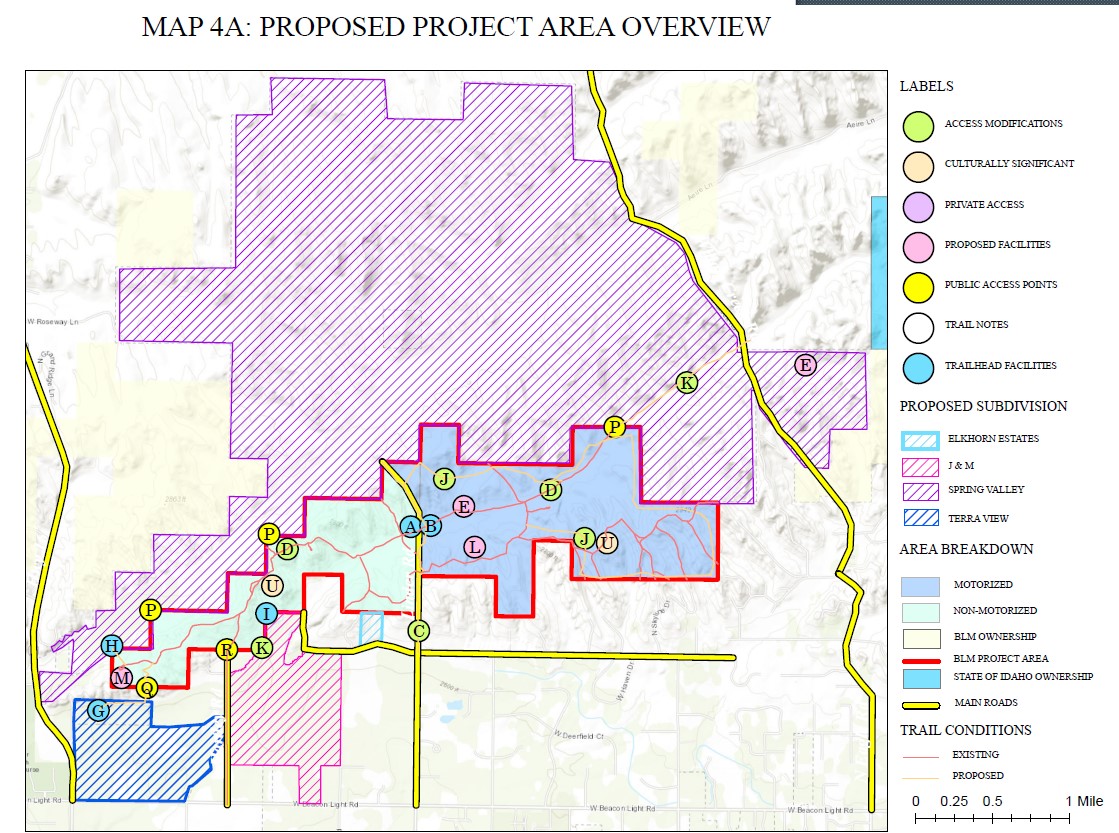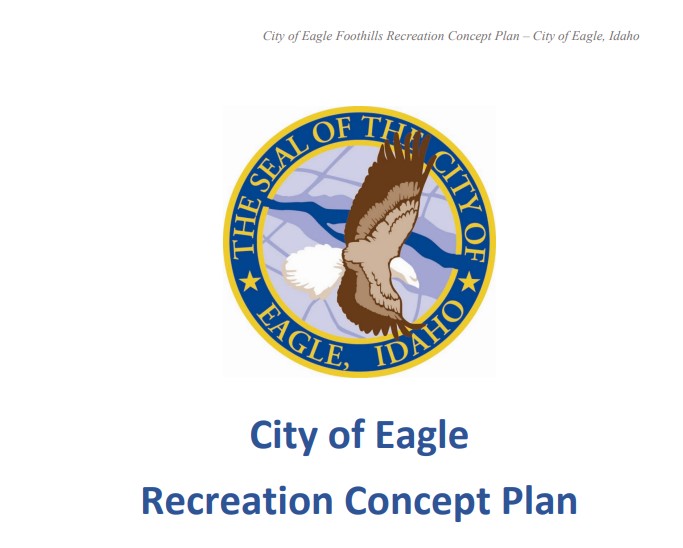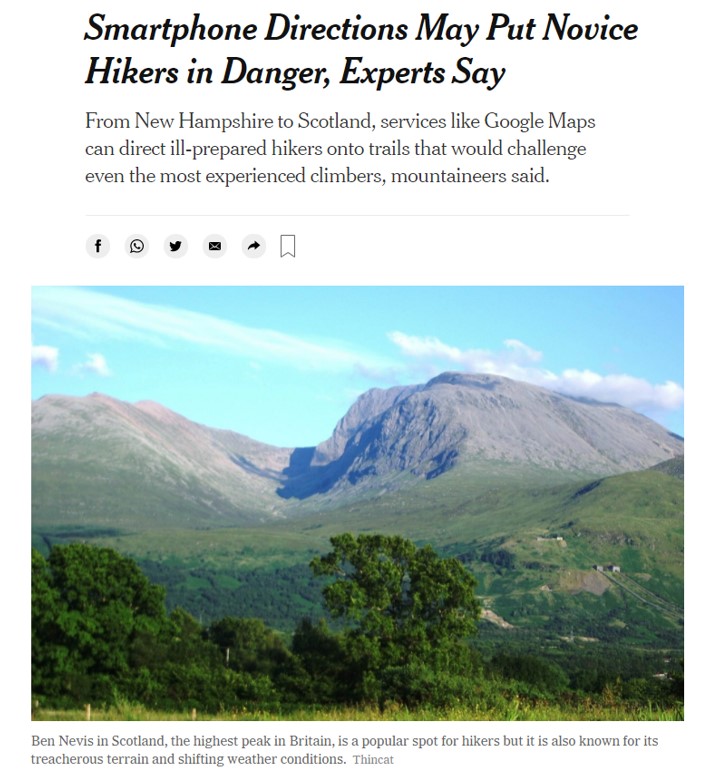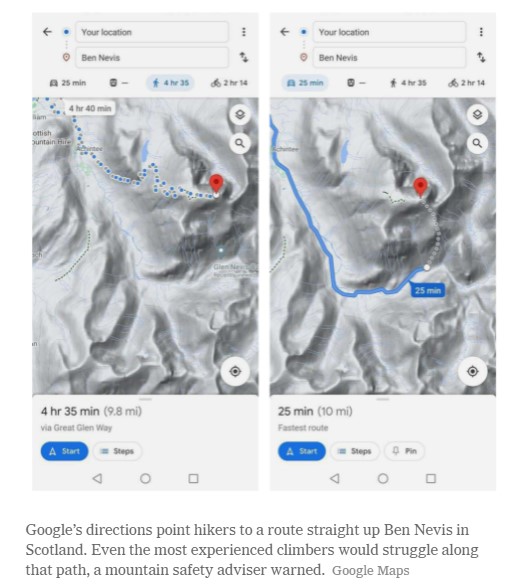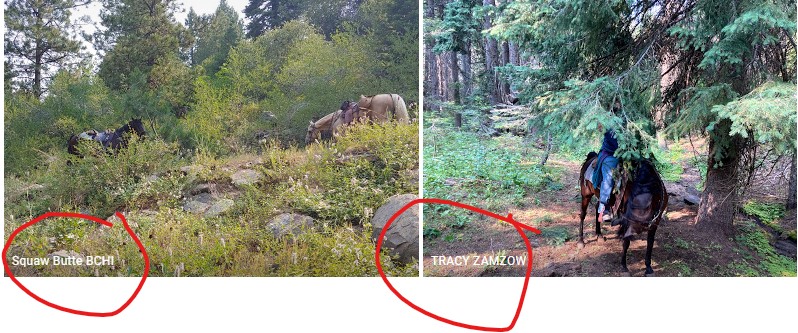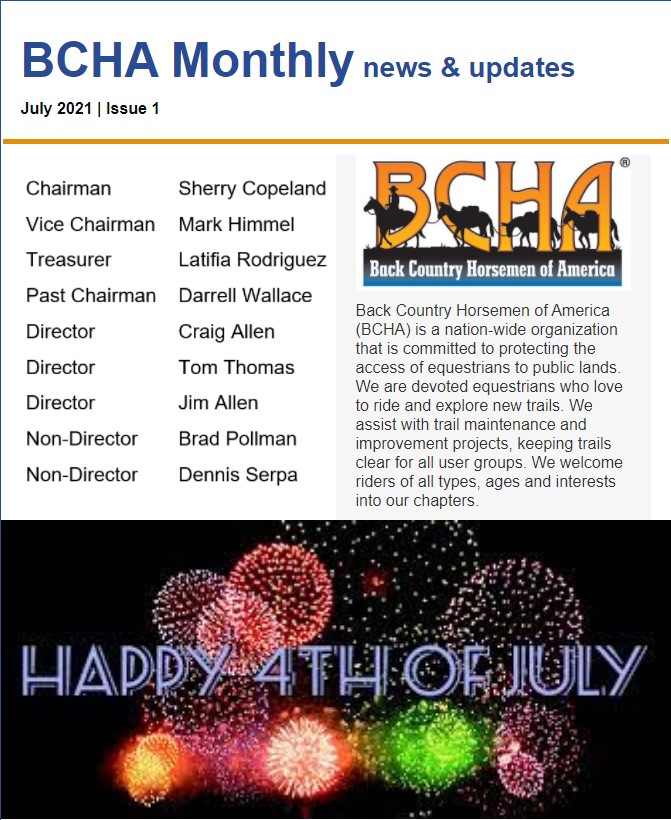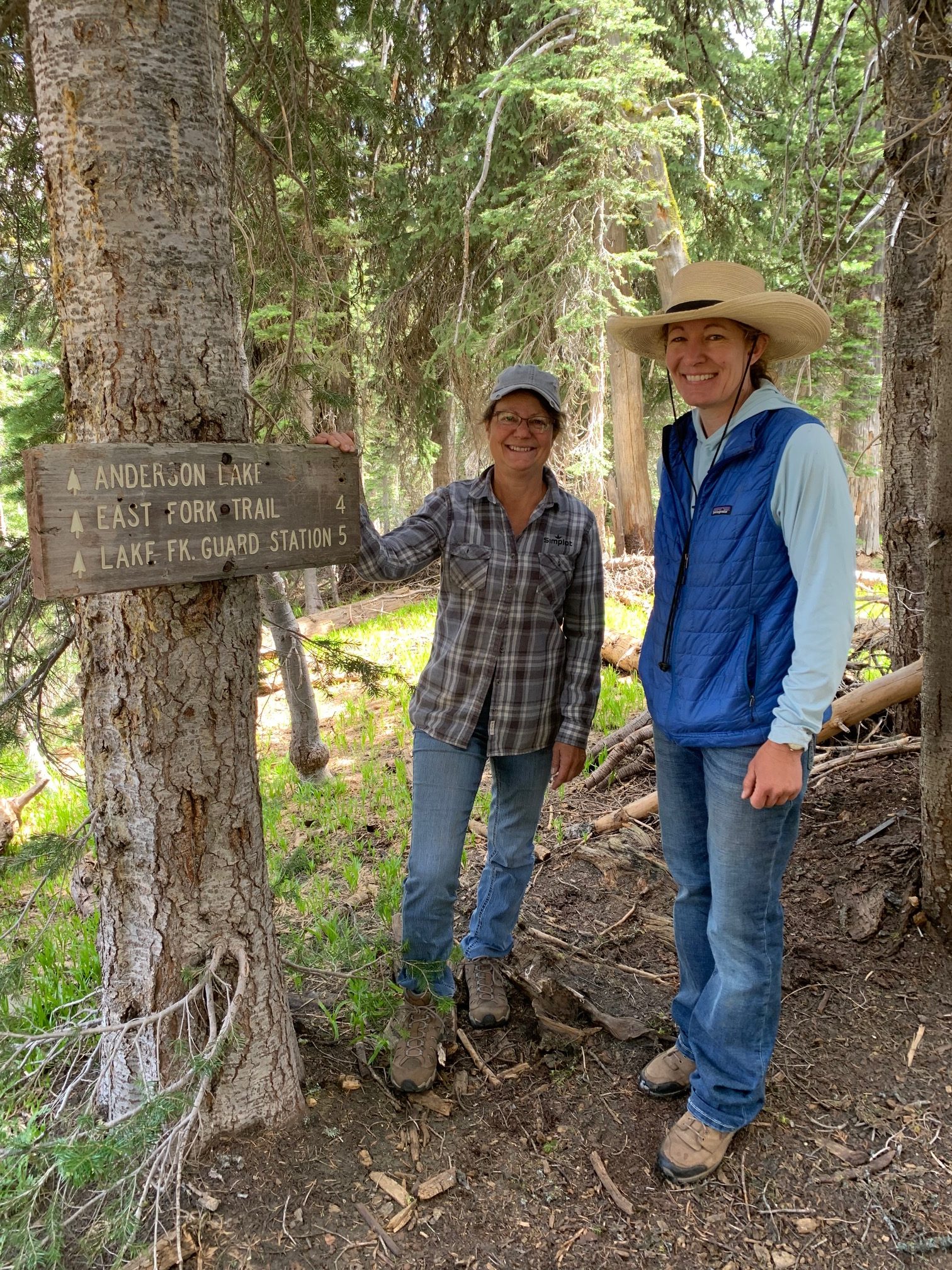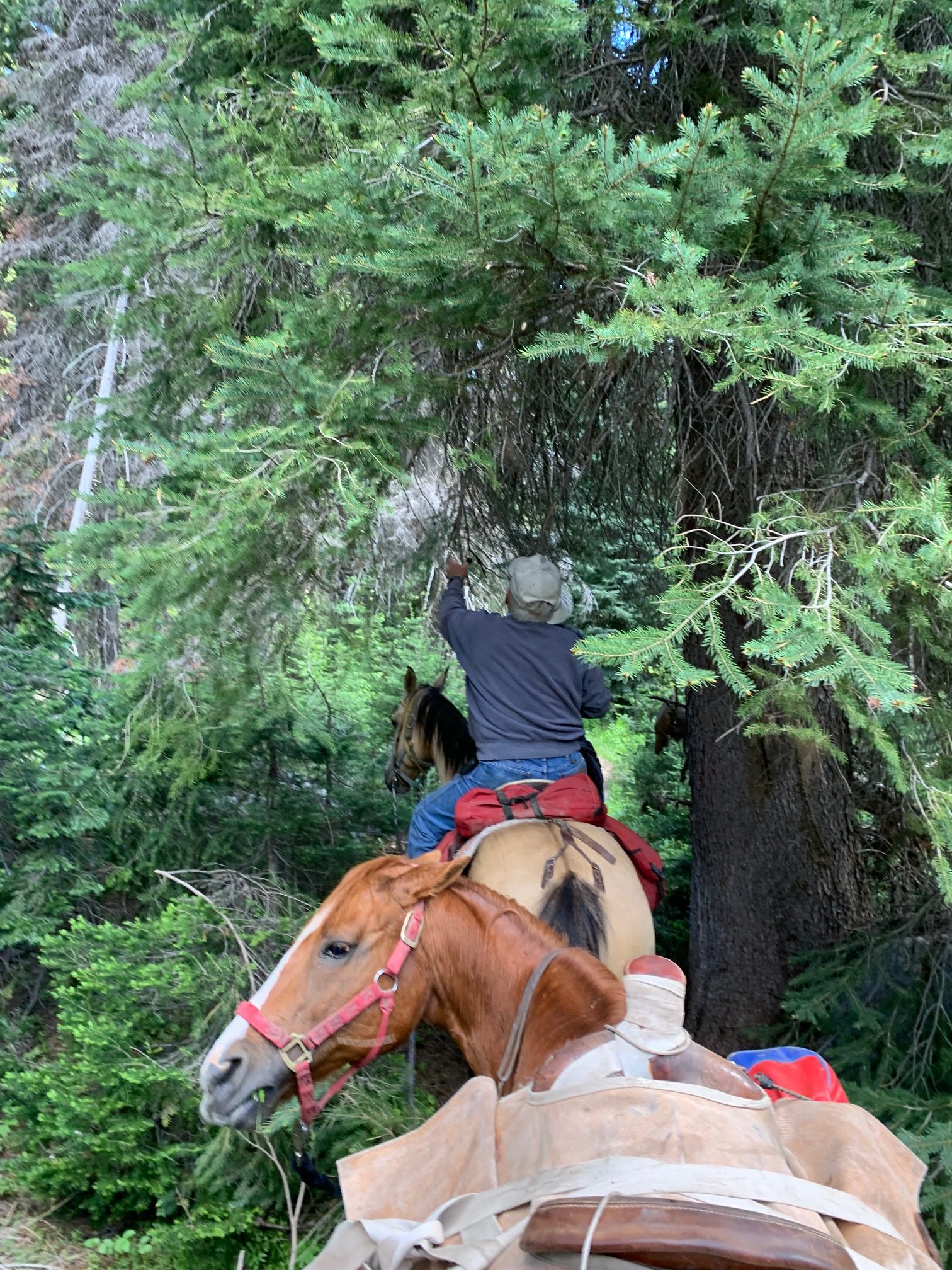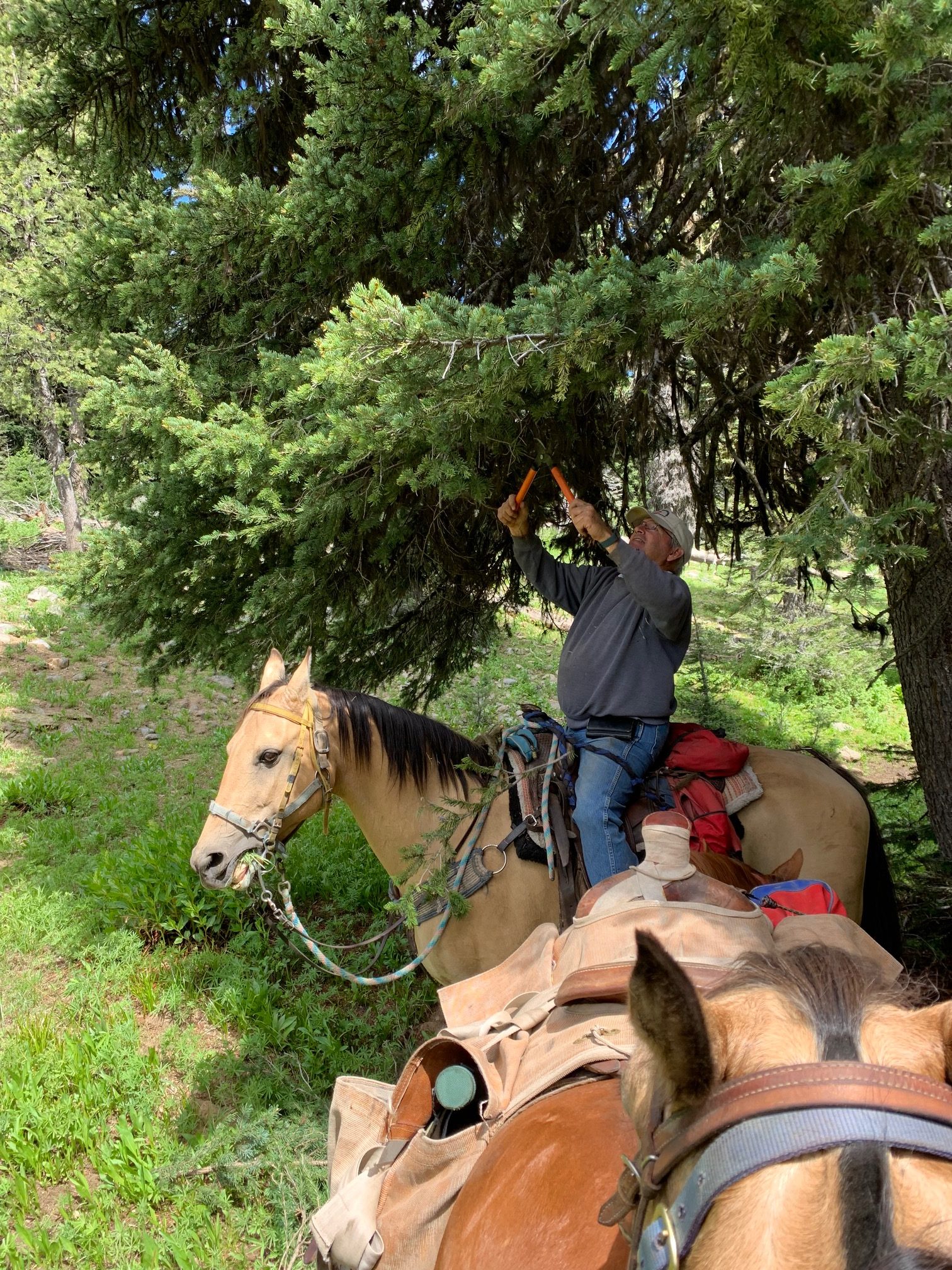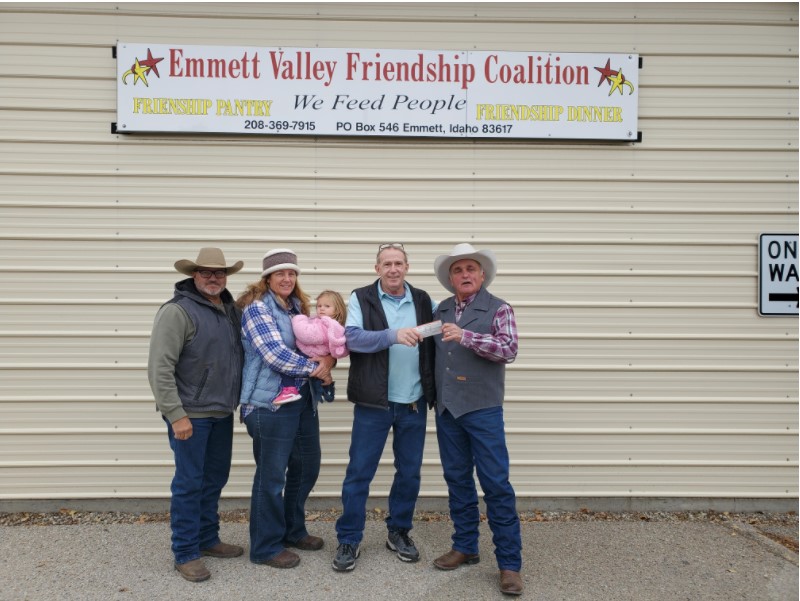
Squaw Butte Chapter officers deliver Checks and food donations to the Gem County Food Bank and PALS
Scott Morgan, Heather Donesky & granddaughter, Ron Fergie, Pictures taken by Lisa Deas.
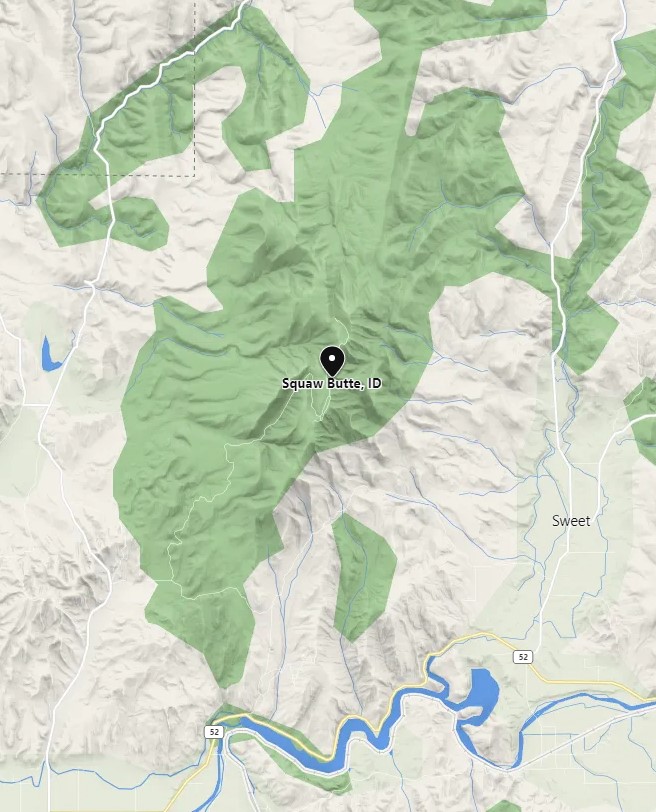
The Squaw Butte Ridge is about 8 miles long, runs generally north to south, and has a steep eastern front that rises from about 2500 feet near Sweet and Ola, Idaho to 5500-5800 along the top of the ridge. If viewed from the south or east, it appears that the Squaw Butte ridge is a separate or island-like mountain. Native Americans used the slopes of Squaw Butte as their wintering ground and it’s been claimed that they, not the white man, assigned the Squaw name to this prominent landmark. Nearby Timber Butte is also known as a wintering area and the region’s volcanic rock has been used by natives to quarry and make weapons. In the early 1800’s white men settled the area as ranchers, farmers, and gold miners. The tiny towns of Ola, Sweet, Montour, Letha, and Roystone were some of the first settlements with the town of Emmett developing into a prosperous fruit farming area (due in part to the fertile soil).
Interior Secretary Haaland moves to rid U.S. of racially derogatory place names
- U.S. Interior Secretary Deb Haaland announced that the federal agency will establish a process to review and replace racially derogatory terms used in place names.
- Haaland, the nation’s first Native American Cabinet secretary, said a newly-created federal advisory committee will review and recommend changes to derogatory geographic and federal land names.
- She also declared the term “squaw,” a pejorative for Indigenous women, to be derogatory and ordered to remove the term from federal usage.
-
U.S. Interior Secretary Deb Haaland announced Friday that the federal agency will establish a process to review and replace racially derogatory terms used in place names.
Haaland, the nation’s first Native American Cabinet secretary, said a newly-created federal advisory committee will review and recommend changes to derogatory federal land names, according to a U.S. Department of Interior press release.
The committee, through a new Derogatory Geographic Names Task Force, will consult with the public and tribal representatives on potential place name changes.
Haaland also declared the term “squaw,” a pejorative for Indigenous women, to be derogatory, the press release said. She ordered the Board Geographic Names, the federal body tasked with naming geographic places, to develop procedures that would remove the term from federal usage.
“Squaw” currently appears in the names of more than 650 federal land units, according to Board Geographic Names data.
“Racist terms have no place in our vernacular or on our federal lands. Our nation’s lands and waters should be places to celebrate the outdoors and our shared cultural heritage – not to perpetuate the legacies of oppression,” Haaland said in the press release.
“Today’s actions will accelerate an important process to reconcile derogatory place names and mark a significant step in honoring the ancestors who have stewarded our lands since time immemorial,” she said.
Haaland noted that it typically takes years for the Board of Geographic Names to replace place names as their review process is by a case-by-case basis. There are currently hundreds of name changes pending before the board, according to the press release.
The new federal advisory committee aims to make this process more efficient by facilitating a “proactive and systematic development and review” of name change proposals, the press release said.
Some advocates welcomed Haaland’s Friday announcement, saying that the move by the federal government is long overdue.
“Names that still use derogatory terms are an embarrassing legacy of this country’s colonialist and racist past,” said John Echohawk, executive director of the Native American Rights Fund, in a statement. “It is well-past time for us, as a nation, to move forward, beyond these derogatory terms, and show Native people — and all people — equal respect.”
“We applaud Secretary Halaand for taking action to make our federal government and public lands more inclusive and respectful of Native peoples,” Echohawk continued.
Paul Spitler, senior legislative policy manager of non-profit land conservation organization The Wilderness Society, also applauded the announcement.
“The names of our mountains and rivers should honor and reflect our nation’s great diversity, and advance dignity for all people,” Spitler said in a statement Friday. “We support the Biden administration’s actions to eliminate the thousands of racist and offensive place names on public lands and to work with diverse populations in local communities to create more equitable and inclusive outdoor spaces for all people.”
The Secretary of Interior and Board of Geographic Names have made similar moves to replace derogatory place names and terms over the years.
In 1962, then-Secretary of Interior Stewart Udall directed the board to eliminate the use of the N-word. And in 1974, the board identified a pejorative term for “Japanese” as derogatory and eliminated its use as well.
The board also voted in 2008 to change the name of a mountain in Phoenix from “Squaw” Peak to Piestewa Peak, in honor of Army Spc. Lori Piestewa, the first Native American woman to die in combat while serving in the U.S. military.
Some states have also passed legislation to prohibit the use of the word “squaw” in place names, including Oregon, Maine, Montana and Minnesota, according to the press release.
Earlier this year, Congressional Democrats also introduced legislation in July to rename more than 1,000 places in the U.S. that feature offensive language and racist slurs, Business Insider reported.
Name changing has also occurred in the private sector. In September, the Squaw Valley Ski Resort in California changed its name to Palisades Tahoe. The ski resort is in the Olympic valley, which was formerly known as “Squaw” Valley until it hosted the 1960 Winter Olympics.
ITA partnered with Wild Hearts Idaho this year for an all-girls youth trail maintenance trip in the Gospel Hump Wilderness! From a thrilling (and wet!) jet boat ride up the Salmon River to living out of their backpacks for a week, these girls had quite the adventure in Idaho’s backcountry.
Thank you to the Nez Perce-Clearwater National Forest, the Sawtooth National Forest, and Mackay Bar Outfitters for your support on this project.
The Kennelly Creek weekend project scheduled for September 18 is generally a popular and well attended project. This weekend for various reasons it was not! Rob Adams plus three other members signed up for the project. On Thursday one dropped out and one said that they would be coming up early Saturday morning. On Friday, I packed up my trailer loaded, the newly prepped saws and gear and around noon headed up 55 towards Donnelly, ID. I turned on to Paddy Flat road and when the surface changed from paved to gravel, stopped and put my truck in low range 4-wheel drive for the climb up to Paddy Flat summit. Paddy Flat road is a good US forest service type road that winds along hill sides with the first section on private land holding that has had some logging or thinning this summer. There are some very narrow spots but there are generally good places to pass along the road if you go slow and watch for oncoming traffic. Wood gathering and hunting are both going on this time of year, to there is more traffic than is typical on a week day. The drive into the trail head is 13 miles and at mile 7, I came around a blind corner and saw a small SUV pulling a heavily loaded single axel trailer up the middle of the road towards me. What I expected to happen was he would pull over against the hill side and we would sneak past each other and continue on our way. What happen is he did move over a bit and I got my trailer straight behind the truck as far over as I felt safe. Watching the mirror it looked like we might make it. At the last minute he slammed on his brakes and I tried to get my rig stopped before we hit. I was about a foot long, folding his trailer fender up, cutting gashes in both his and my trailer tires.
We had him back up a bit and I could get by and then we surveyed the situation and started working on his trailer first.
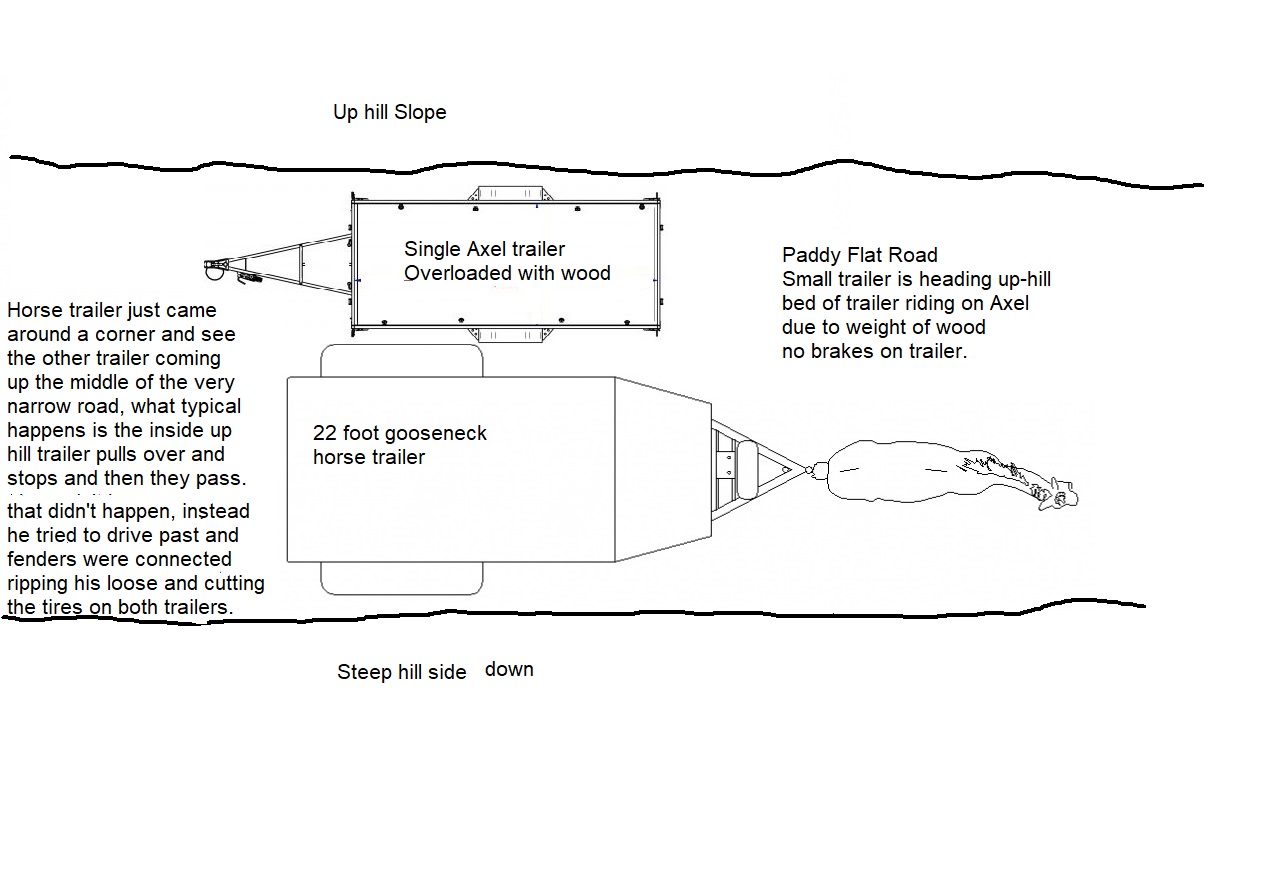 His tire needed to be changed which required jacking up his trailer, His jack would not do the job, but I had stuff to help get that done, once the tire was off, it became clear that the front mount on the axel spring had broken so it was likely that the axel could fold up under the trailer. We rigged a chain to hold it in place, used a big hammer to get the fender out of the way and installed a spare that he hoped would get him to McCall. He promised to go really slow and I know for a fact he made it into town. I took my spare off the front of the trailer and swapped out the wrecked one and 30 minutes later was at the camp ground.
His tire needed to be changed which required jacking up his trailer, His jack would not do the job, but I had stuff to help get that done, once the tire was off, it became clear that the front mount on the axel spring had broken so it was likely that the axel could fold up under the trailer. We rigged a chain to hold it in place, used a big hammer to get the fender out of the way and installed a spare that he hoped would get him to McCall. He promised to go really slow and I know for a fact he made it into town. I took my spare off the front of the trailer and swapped out the wrecked one and 30 minutes later was at the camp ground.
I was the only one there, a surprise, it being a Friday afternoon. At 18:30 I grilled a pork chop and by 21:00 it was getting dark and cool, so said good night to the stock and crawled in by bag to read a book before going to sleep. Around 21:30 two pickup came into the camp ground and set up tents, but none with horse trailer.
At 07:30 on Saturday I got up, fed the stock, made some breakfast and then packed up my camping stuff as I planned to head home at the end of the day as a front was expected. By 09:30 I was all saddle and had the equipment packed on my mare and happened to look down at the tire next to where Payette was tied. It was nice and round on top and totally flat on the bottom. $H!T!!!, every back country horsemen nightmare is two trailer flats on the same trip!. I knew it was ok on Friday, but assumed it was also damaged by the fender-bender.
On to plan “B”, I un-saddled the stock and put them back on the high-line with some more certified hay so they were happy but confused. Disconnected the truck and headed with the slashed tired to McCall with hopes of getting a new one mounted. Les Schwab had what I needed and had one mounted and balanced in about 30 minutes and it was back to the trail head. Still no other horse trailers. I pulled the second flat to find a big screw in it so it had nothing to do with the fender-bender. Got the new one mounted and then drove out of the trail head had very carefully making sure I could see and could get pulled over if necessary as I passed a number of hunters on 4-wheeler, side-by-sides and trucks. Getting backed to the paved road was a great relief.
Summary of weekend, No trees cut, No brush removed, No nice ride in the mountains. One great pork chop dinner at a very pretty trail head, minor damage to my trailer fender and two very pricey new trailer tires and a new rim so I can carry two spares going forward. Not the best way to end what had been a very successful BCHI season. I do wonder what happened to the other two guys, maybe they have similar story’s.
After six years leading and organizing trail projects across Idaho, Clay Jacobson is leaving ITA for new adventures, including hiking the Continental Divide Trail next summer. We will miss you, Clay and wish you the very best!
ITA is looking for a Trail Projects Director. This person will oversee the planning, coordination, logistics, and successful completion of our trail maintenance and monitoring projects. They will also train and empower volunteer crew leaders to lead projects. This position requires a highly motivated and well-organized trail enthusiast with a variety of skill sets. Click here to see the full job description!
To apply, please submit a cover letter, resume, and the contact information for three references in a single PDF. Send via e-mail to jobs@idahotrailsassociation.org with the subject line “Trail Projects Director” by or before October 8th, 2021.
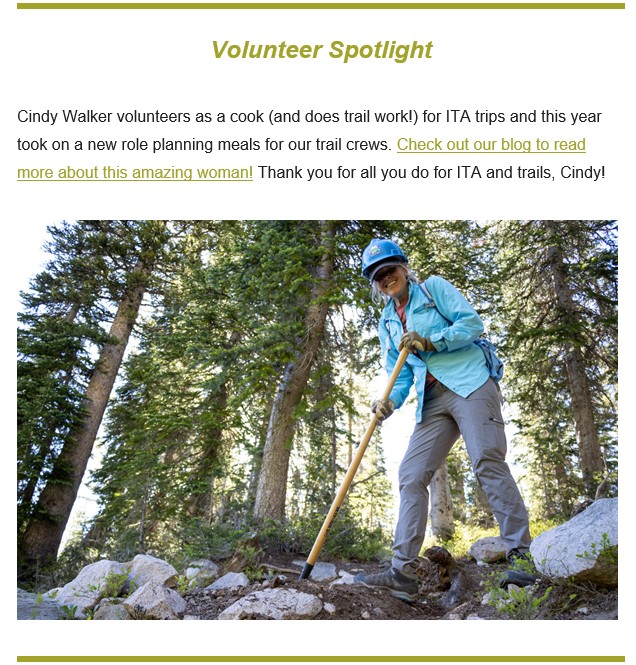
Calendars make great gifts and have a much better chance of paying off than a Loto Ticket!
Contact: Scott Morgan 208-989-0632

Rocking JB is located in beautiful Central Idaho overlooking the Camas Praire. I am a home based business specializing in hats, coats, shirts, bags, & sweat shirts. I take orders for large and small quantities. I can purchase items for you or I can personalize your own items.
Jackets and Vests with the BCHI LOGO on it. That is something that each individual would need to discuss directly with Julie. (208) 983-2183, rockingjbbags@gmail.com, https://www.facebook.com/RockingJbBagsEmbroidery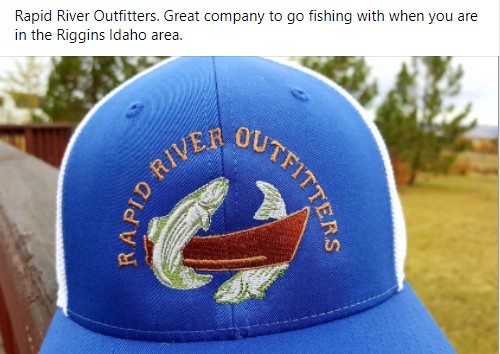
BCHA is a proud sponsor of the new national Trails are Common Ground program. No matter our differences in backgrounds or how we choose to enjoy the great outdoors, trails create common ground that connects us. Access to trails is a privilege we acknowledge and can only safeguard through our actions toward one another. Meeting other people on the trail can be a good experience…or a bad one – Expect to see others on the trail – Respect their right to be there – Be friendly You can make the trails a nicer place to be!
The new national program Trails are Common Ground is an educational program aimed at educating the public on proper trail etiquette when meeting other trail users on our public trails. The BCHA Trails are Common Ground brochure can be downloaded and printed to place at businesses that sell or rent trail related equipment, public agency offices and your favorite trail head.
Jan – Leadership Team
Feb – Birds of Prey Fun Ride / Video
Mar – Wilson Creek – China Ditch / Video
Apr – Succor Creek Natural Area / Video
Apr – Camping with Stock Clinic
May – 4 Mile HMA / Video
Jun – Peace Creek
Jun – Cuddy Mountain
Jul – Bogus Basin Sawyer Workshop
Jul – Wilson Corral – West Mountain
Aug – MCC Twenty Mile Creek
Aug – Squaw Creek TR-131 North
Aug – WV Imogene Lake – Sawtooth
@
– Video’s created by Linda Hughes –
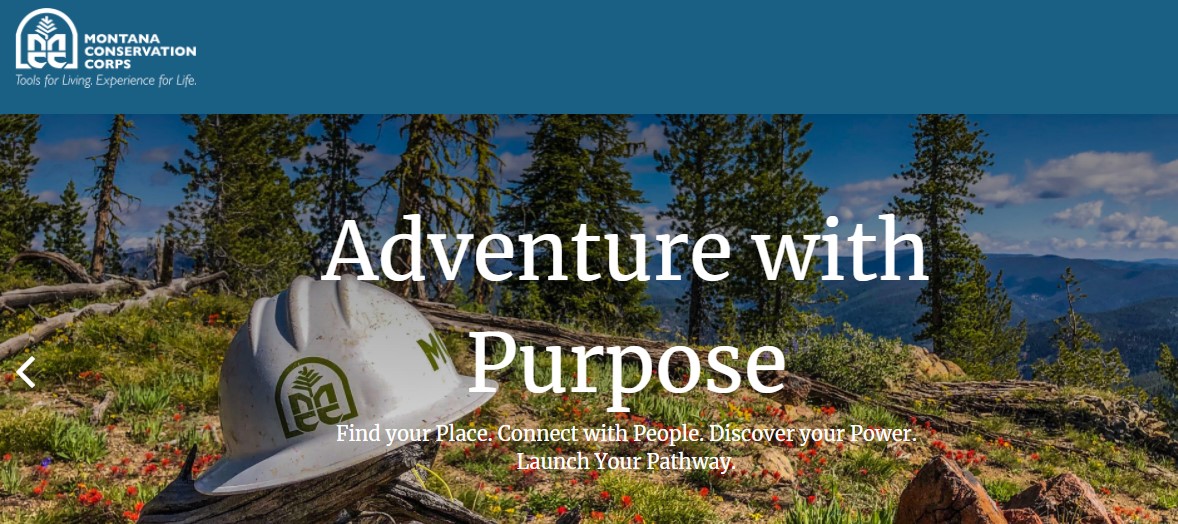

HISTORY
The Montana Conservation Corps grew out of great ideas, great people, and a great legacy. Stories of men joining and serving in the Civilian Conservation Corps during the Great Depression can be heard at coffee counters across Montana. Tales of their accomplishments to improve the landscape – including the development of Montana’s first state park at the Lewis and Clark Caverns – and the spirit of the young people who joined are numerous and verging on mythical, in the best tradition of Montana.
In 1990, Human Resource Development Council agencies from Billings, Bozeman, and Kalispell established the Montana Conservation Corps. Our first Executive Director, Steve Nelsen, tells of starting MCC with nothing but a desk, a phone, and a box of Kleenex.
The first MCC crews were fielded in the summer of 1991 through the cooperation of the HRDC and sponsoring agencies such as the City of Billings, Montana Fish, Wildlife and Parks, and the U.S. Forest Service. In 1993, MCC successfully obtained AmeriCorps funding, which doubled the budget and established regional offices.
Now MCC has a multimillion-dollar budget and has matured into a leader in the national corps movement. We are proud of our humble roots and thankful for all those that have contributed to the development of MCC over the years. To all of our alumni, staff, board volunteers, and community champions—thank you for being a part of the Montana Conservation Corps.
In Mid-July, Adam Larson PNF Trails Supervisor contacted Squaw Butte and ask if they would consider doing a drop camp for an MCC crew working on the Twenty Mile Creek trail near upper Payette Lake. The pack-in date would be August 3rd and pack-out on August 24. This crew of 6 would be working from this base camp for two weeks so need quite a bit of food and had over 90 pounds of hand tools and a chainsaw and support gear. Rob Adams and Phil Ryan met MCC crew Leads Eve Hickey and Dylan Barker and the rest of the team at the Twenty Mile trail head on Tuesday morning at 07:30. The five pack stock were saddled and once the gear was unloaded from their truck, a quick briefing on load building was followed by the MCC crew helping build and hang loads. The biggest challenge was the large pile of hand tools including sledgehammers, picks, Pulaski’s and a rock bar they would need. The tools were distributed between two canvas mantie that once lashed up weighted in at 46 and 47 pounds and were basket hitched to one of Rob pack horses.
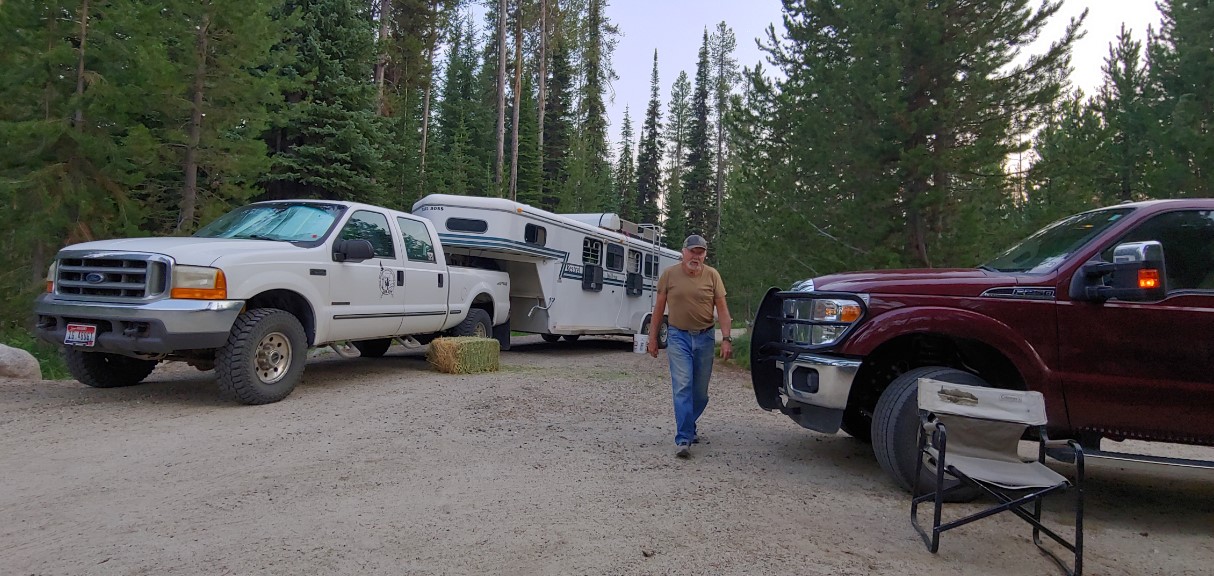
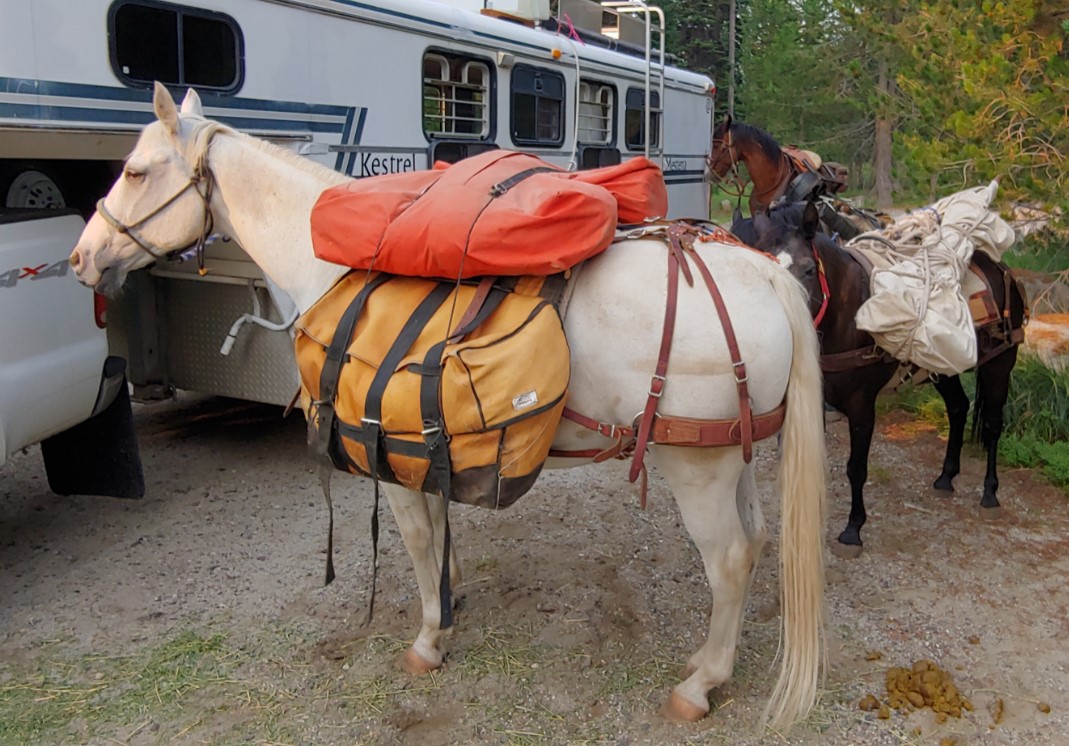
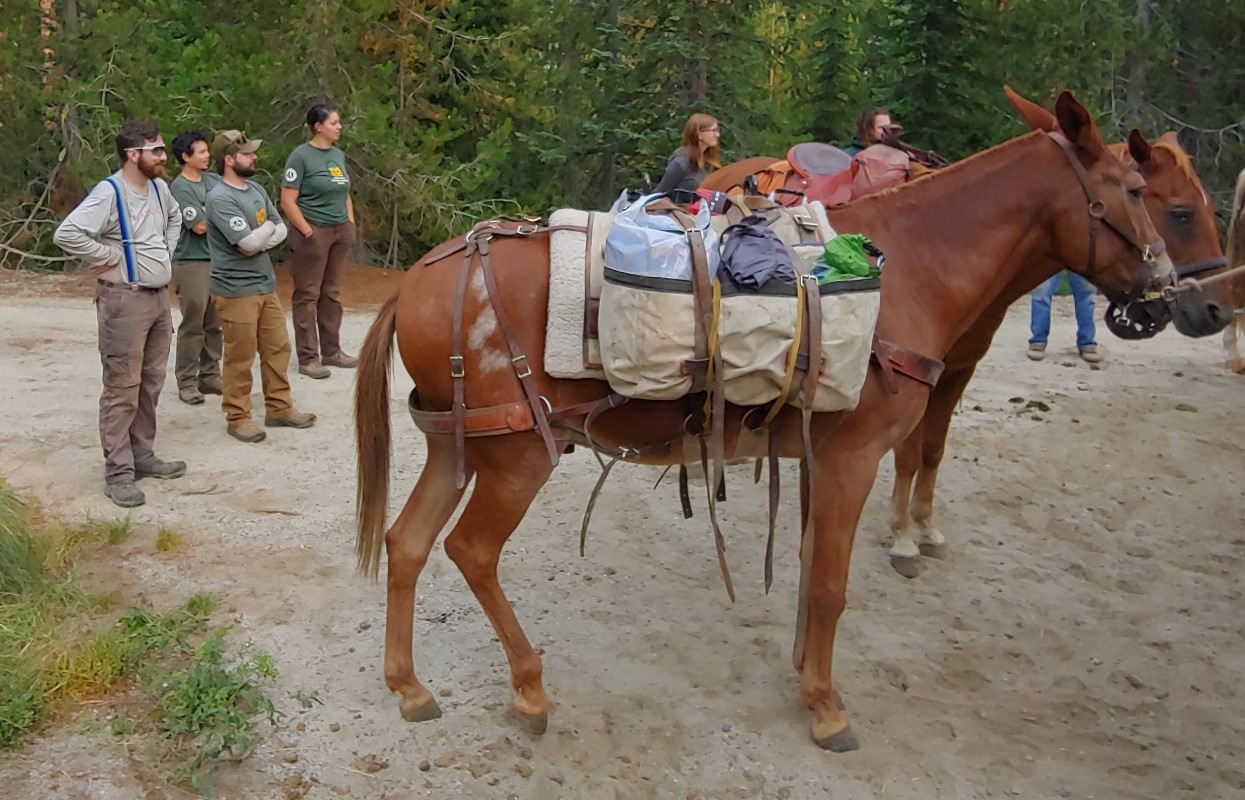 By 08:30 everything was loaded and Rob and Phil were heading down the trail for a bit over 6 miles to a meadow that was their planned camp site. We made good time averaging a bit over 3 mph and were at the camp site by 10:30 and had the stock unloaded and were heading back to the trail head by 11:00.
By 08:30 everything was loaded and Rob and Phil were heading down the trail for a bit over 6 miles to a meadow that was their planned camp site. We made good time averaging a bit over 3 mph and were at the camp site by 10:30 and had the stock unloaded and were heading back to the trail head by 11:00.

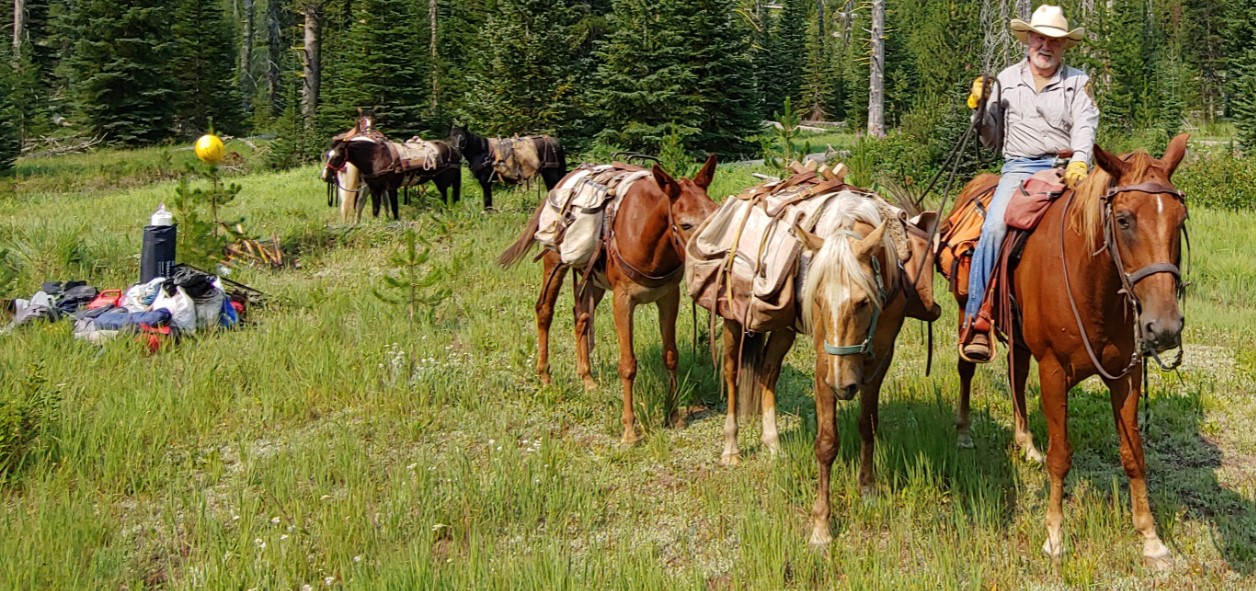
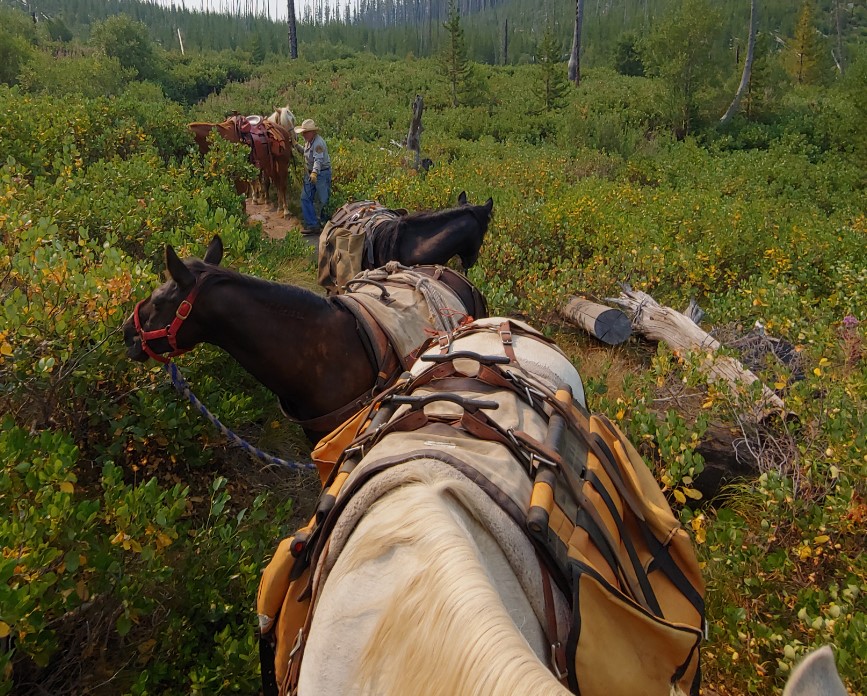 The site we left the gear is going to be a great camp with dry, level ground for their tents, easy access to water and two nice pools for a dip after a hard day of trail work. While on the trail we met three dirt bike rider, two back packers that had been camping up at the Twenty Mile Lakes and two couples and a toddler in a back pack.
The site we left the gear is going to be a great camp with dry, level ground for their tents, easy access to water and two nice pools for a dip after a hard day of trail work. While on the trail we met three dirt bike rider, two back packers that had been camping up at the Twenty Mile Lakes and two couples and a toddler in a back pack.
See planned work PDF: MCC 2021 Twenty Mile Projects

As part of the deal to use the 4-H building to hold chapter meeting during the Covid-19 lockdown Squaw Butte agreed to do a presentation at the 2021 Gem County Fair for the 4-H. This presentation was scheduled by the fair for Saturday July 31, at 13:00 in the 4-H building. Phil Ryan and Rob Adams agreed to do a talk on BCHAI and stock camping on Public Lands. Both arrived at 11:00 to get the lay of the land and to make sure they were set up and ready to go at 13:00. After wandering around for while looking for an Information booth or schedule they tried the fair office and were in luck, someone was there and said yes, we were scheduled for 13:00 at the 4-H build, but they were sorry to say they didn’t do event schedules this year an oversite and as the steer, lamb and hog sale was going on it was unlikely we would have many show up. They were right, we had three, a couple enjoying the AC for a few minutes and a young girl who told us about her rabbit. If interested the high steer went for 7,500, the average steer went between 5 & 6 K and prime sheep between 1,500 and 2,000. They had not gotten to hogs before we left.
From the bidding pen to your freezer
So, to summarize: A 1200 steer, ½ inch fat, average muscling, yields a 750 pound carcass. The 750 pound carcass yields approximately:
- 490 pounds boneless trimmed beef
- 150 pounds fat trim
- 110 pounds bone
A specific example of how the 490 pounds of boneless, trimmed beef could break out includes:
- 185 pounds lean trim, or ground beef
- 85 pounds round roasts and steaks
- 90 pounds chuck roasts and steaks
- 80 pounds rib and loin steaks
- 50 pounds other cuts (brisket, flank, short ribs, skirt steak)
Maybe this helps explain how the products from a 1200 pound steer to fit in your freezer!
MINIMUM & MAXIMUM WEIGHTS FOR 4-H MARKET LAMBS FOR THE COUNTY FAIR 4-H MARKET ANIMAL SALE ARE MINIMUM: 100 MAXIMUM: 160, THESE WEIGHTS REFLECT THE STANDARDS IN TODAY’S MARKET. ANY LAMB WEIGHING OVER 160 POUNDS WILL SELL AT 160 POUNDS.
4-H’ers must own or manage their lamb at least 60 days prior to our County Fair. Lambs should weigh somewhere
around 65 – 70 pounds by June 1, in order to reach the minimum weight of 100 pounds by fair. If the lamb is wormed,
proper genetics have been followed and good feed has been given they should gain at least .6 pounds a day. A 100 pound lamb will yield around 40 pounds of meet in your freezer.
If we do this again in the future Saturday at 13:00 is not a prime time to generate interest in BCHI!

xxx
Picture this
A cow elk gives birth to a calf in the mountains of Idaho.
The calf spends the next six months in its lush summer range before following a well-worn migratory path to a neighboring valley to spend the winter.
That critical winter habitat includes property owned by a family who manages the land to benefit their ranching operation.
The calf, a bull, returns winter after winter to that same ranch in the valley.
Years later a hunter hears the shrill bugle of a bull elk high on a mountain one September morning. Slowly the hunter inches closer. Finally within shooting range, they shoot, their arrow finding it’s target, the bull providing a year’s worth of meat to the hunter’s family.
The story of the hunter and the bull, one common across Idaho, was made possible thanks to the benefits private land provided to that animal during its lifetime.
Private lands in Idaho
Roughly 31% of the land in Idaho is privately owned. Wildlife, of course, does not adhere to the same property boundaries as humans. Migratory species especially rely on a patchwork of land ownership to survive from year to year, whether that land is someone’s private ranch, farm, or expansive BLM-managed sagebrush steppe.
So shouldn’t habitat conservation efforts be just as diverse?
This is where the US Fish and Wildlife’s Partners for Fish and Wildlife Program (Partners Program) comes into play.
Working alongside willing landowners and within designated priority landscapes, the Partners Program began in 2006 and has become a shining example of the possibilities for habitat conservation on private land.
“These lands have to have three foundational components to ensure they’re viable: looking through economic, ecological and social lenses”, said Jason Pyron, a wildlife biologist with USFWS who oversees Idaho’s Partners for Fish and Wildlife Program.
Landowners tend to focus on the economic lens, while balancing that alongside social and ecological lenses. Idaho’s hunting and fishing community will keep the ecological lens at the forefront. This overlap offers many opportunities to collaborate and provide benefits to all stakeholders.
“We have some highly migratory species in Idaho, and due to the way our landscape is dissected by private lands in valley bottoms, we are at a high risk of losing significant proportions of these populations if we don’t incentivize landowners to keep these lands open. I hope the hunting and fishing community fully appreciates what these landscapes do”, added Pyron.
Where the needs of wildlife and the needs of private landowners collide is where the Partners Program comes into play. READ MORE
Posted by Dan Waugh ( tacpdan@gmail.com)
The city of Eagle is looking for inputs from trail users (Equestrians) for an ongoing project of over 1,600 acres in the northwest corner of eagle with a possibility to expand to 2,200. The city will be developing a trail system in the eagle foothills on BLM land. But, the city of eagle will run the trail system. Over 1200 citizens have been engaging so far and the city staff members are looking for more input.
Marja (360-791-1591), Arlynn (208-249-2091), and I are actively working with the project manager as the IHC Trails and Urban Spaces Committee. But, we would love to get additional views and feedback from other equestrians who will likely use this trail system. Feel free to disseminate to any and all equestrians!
PDF: Foothills_Recreation_Plan_20_July2021_202107220914014507
Link to the Eagle Foothills Concept Plan: New Submission (cityofeagle.org)
Leave comments at the link above!
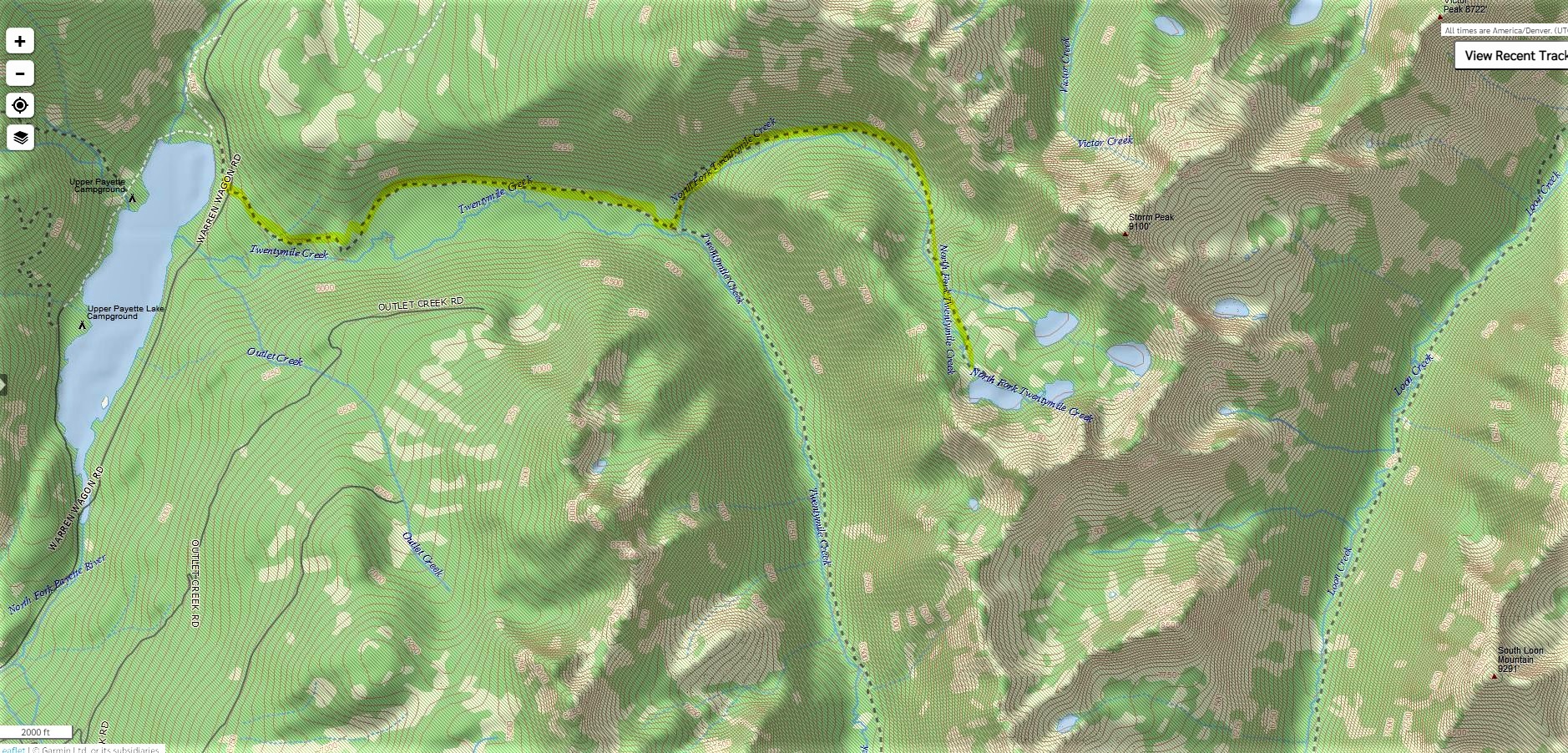 Lat: 45.133938 Lon: -116.010818
Lat: 45.133938 Lon: -116.010818
Tuesday July 20, 2021 dawned cool and damp at the Twenty Mile Creek trail head, the rain from the day before had cooled the air as well as the 5,819 foot altitude. Phil Ryan and Rob Adams had driven up the night before to work on a project on the Twenty Miles lake Trail. They were joined by Shelly Duff and Lisa Griffith who were on vacation and camped near the trailhead. Phil and Rob were on the trail be 08:45 and made good time on the Twenty Mile Creek trail which was in excellent shape. Once they turned on to the Lakes trail they started encountering heavy brush and down fall.
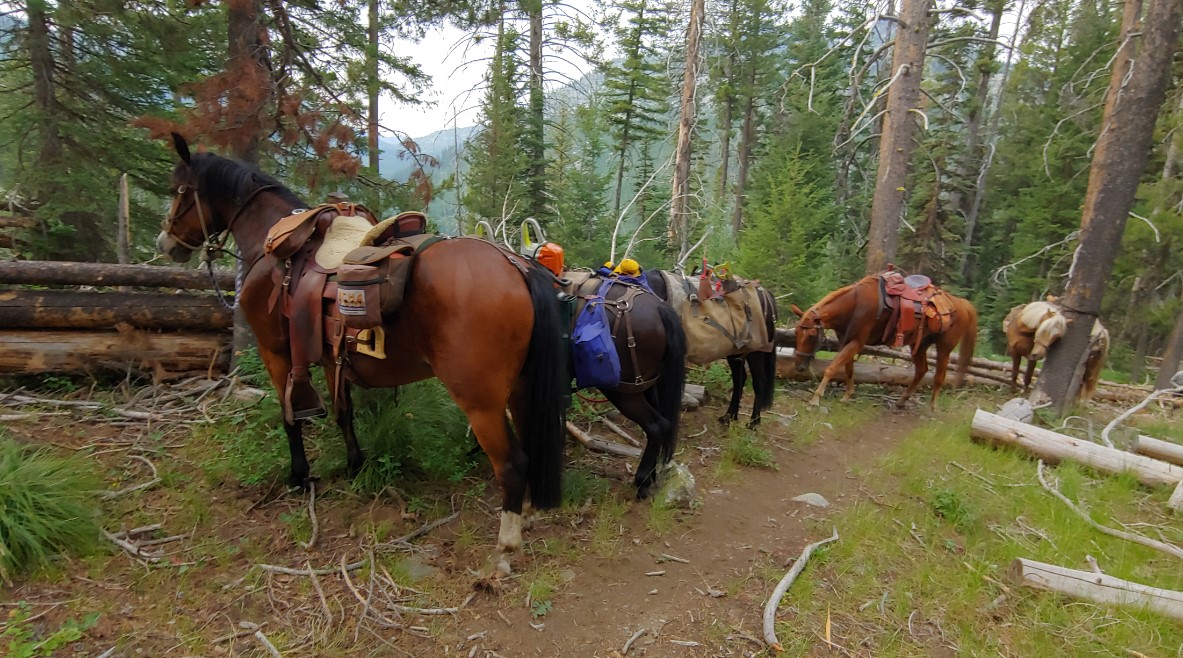
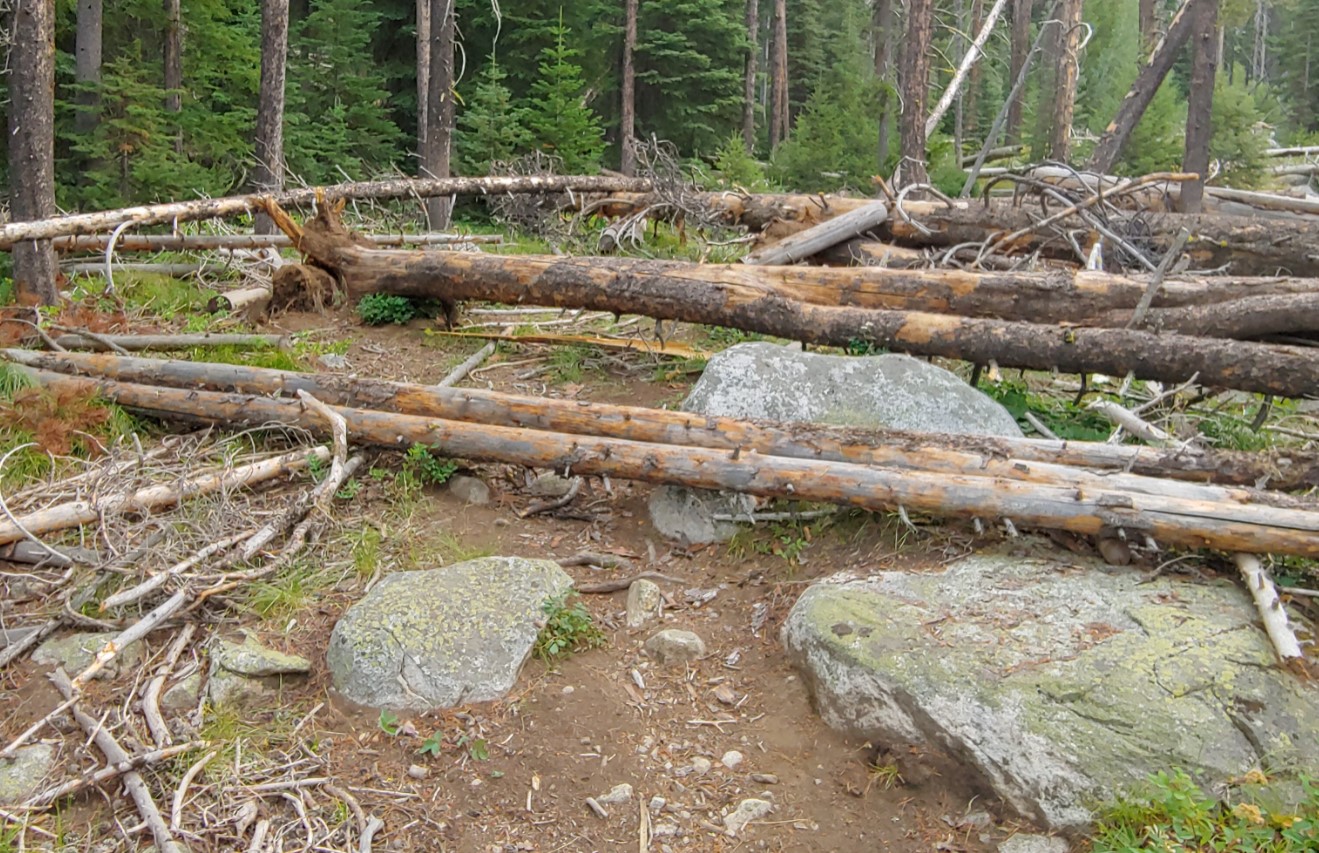
Before

After

Around 10:00 it started to mist, which felt pretty good as we had now soaked our shirts with sweat cutting out down trees and nipping brush. The brush was also wet so the rain made little difference in how wet we became. Lisa and Shelly who left the trail head after us, caught up and took over brushing allowing Phil and I to push on concentrating on down trees.
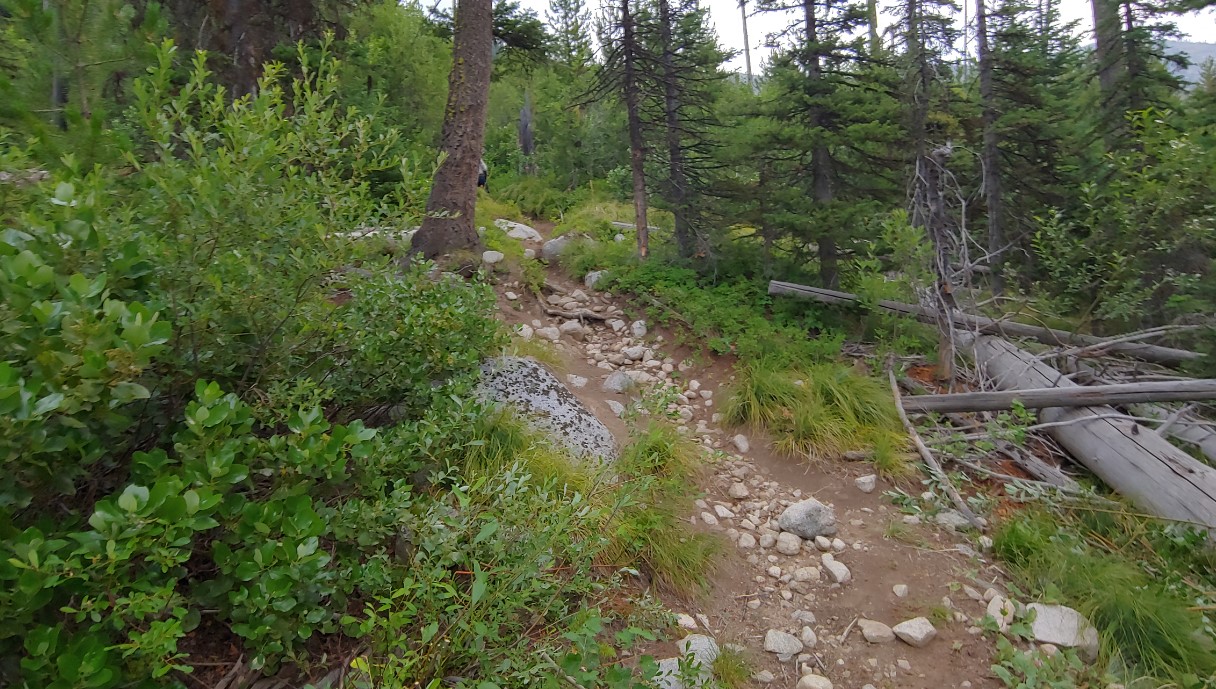
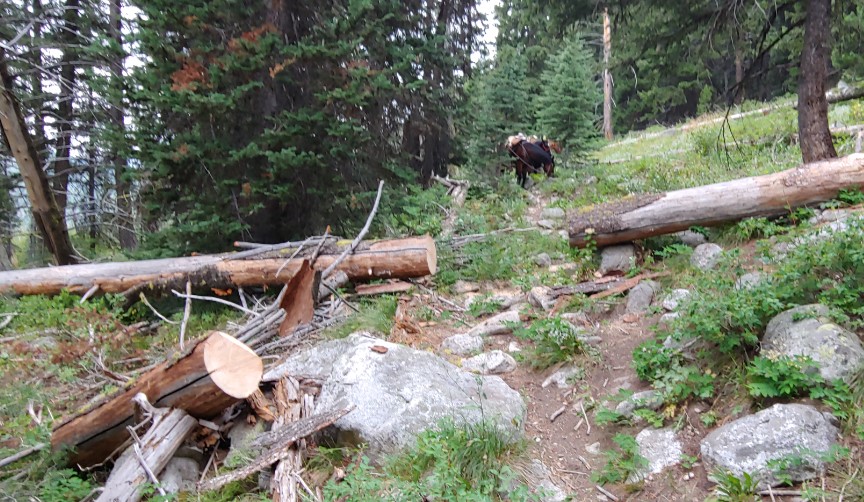
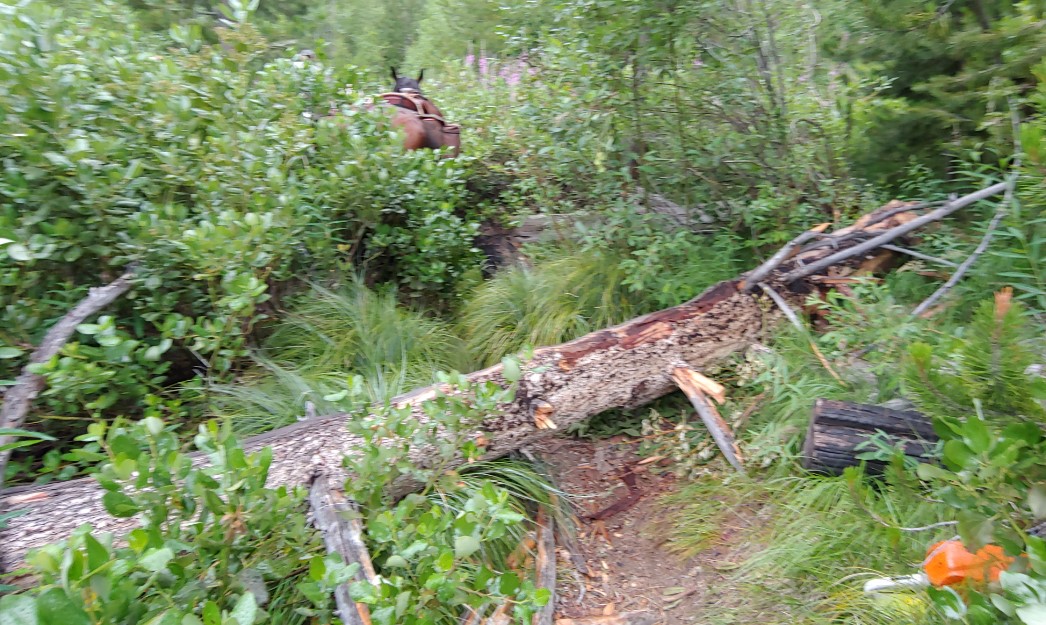
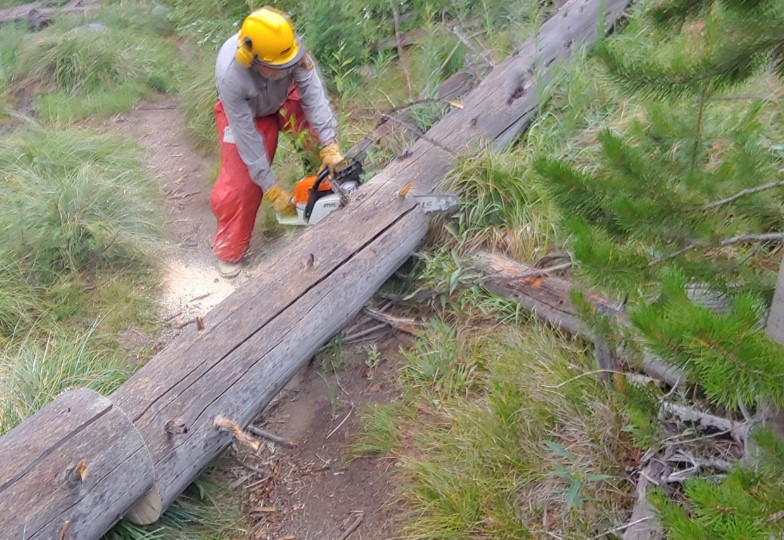
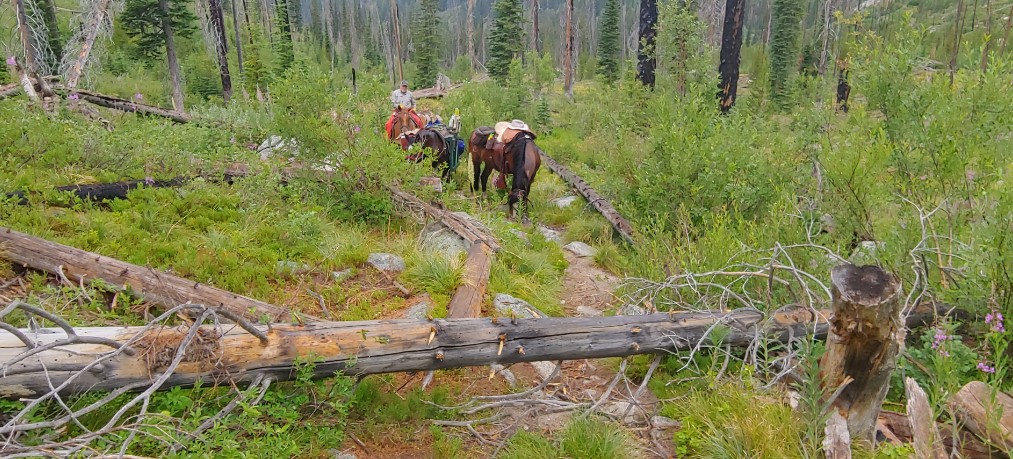
We reached the first lake by 13:30, it was raining and we were soaked and tired, behind us were 35 trees we had remove and large sections of brush cut back. After a quick break we started the ride back to the trail head, arriving at 14:30. The sun came out during the ride back for a short time.
The lakes trail climbs from 6050 feet to 7,719 in three miles, with most of the altitude gain in two sections of steep, rocky switch backs. But the lakes and beauty of the area make it worth the effort.
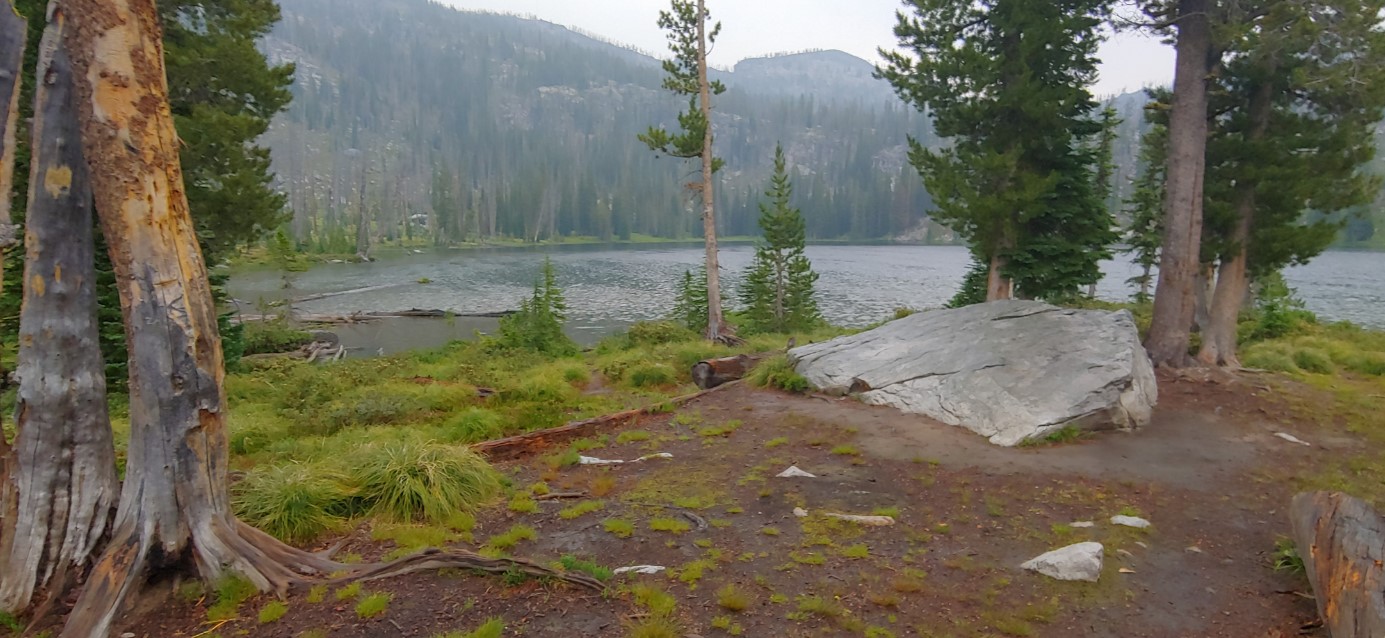
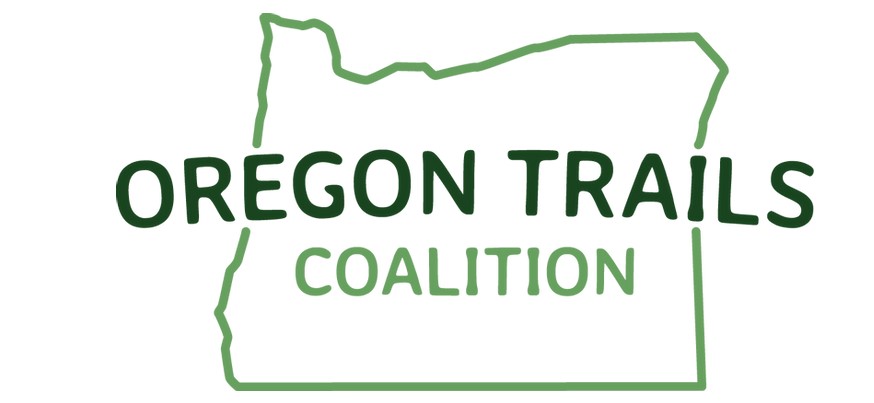
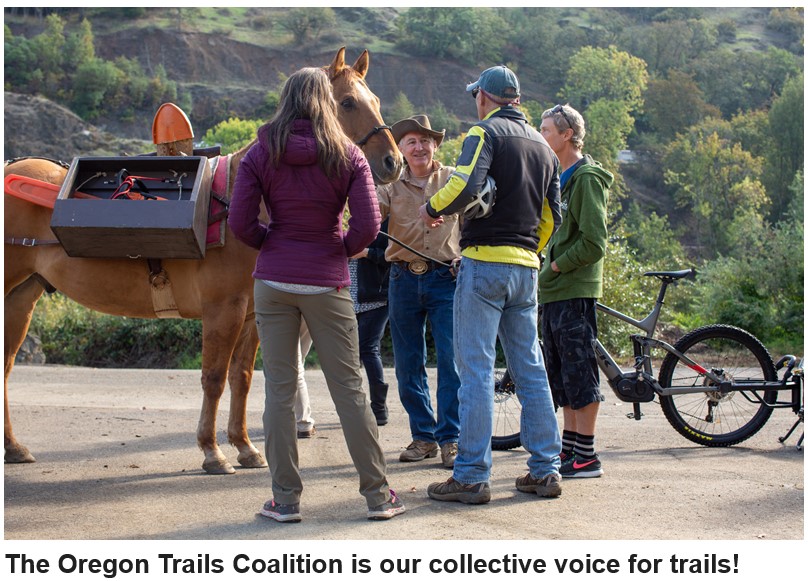
The Oregon Trails Coalition BLOG is a great source of information for all things trails and is worth checking out and getting on their mailing list.
An example is their piece on Trail Planning
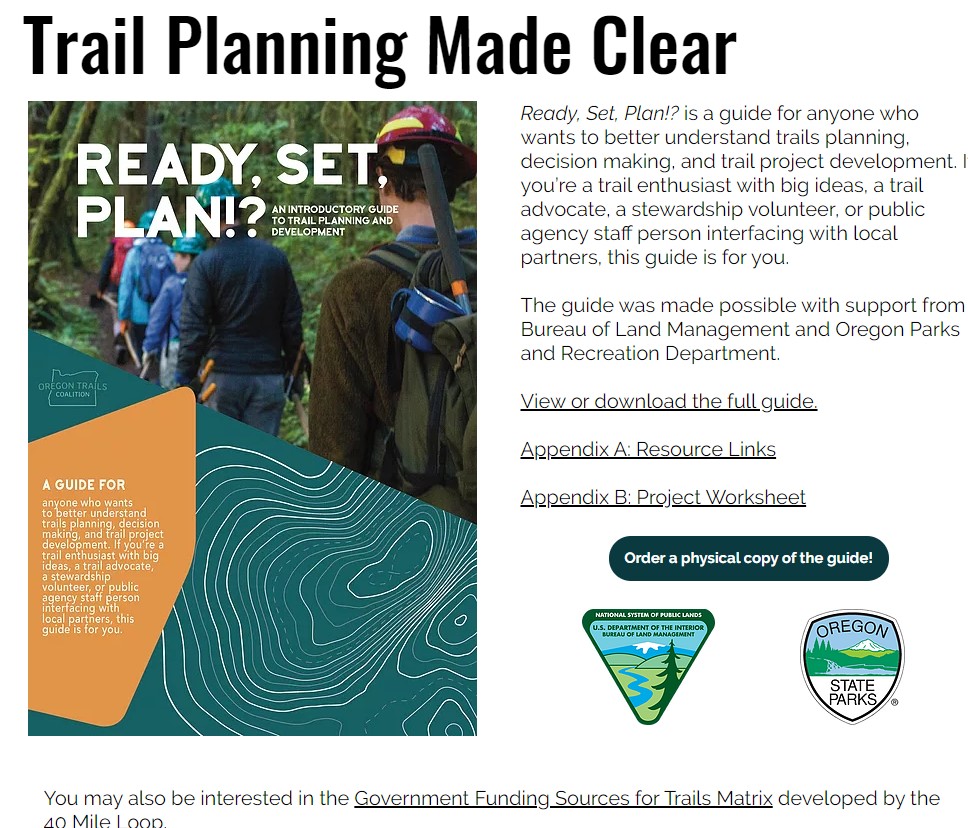
Submitted by: Robbin Schindele
Crater Lake Wilderness Campaign Coordinator
539 SE Main Street
Roseburg, OR 97443
208.365.1789

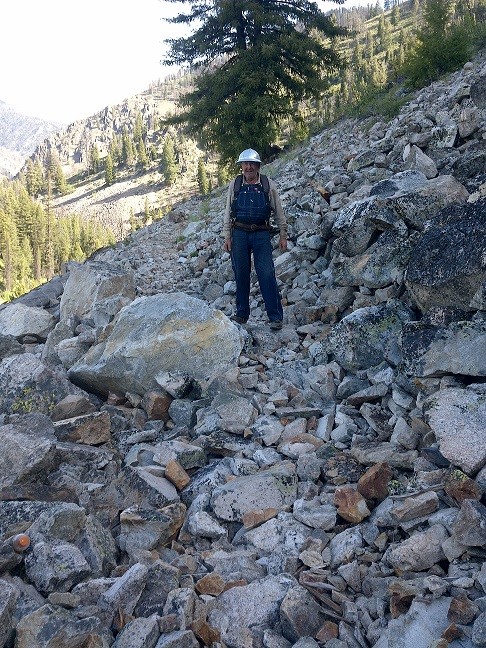 Joe on the “new” trail, beside bypassed rock with others below left
Joe on the “new” trail, beside bypassed rock with others below left
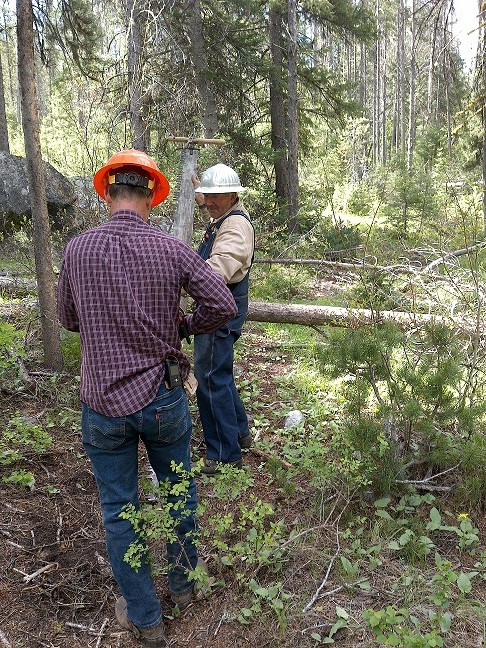 Bart and Joe on a “practice” tree
Bart and Joe on a “practice” tree
 Brian, Bart, Lew & Joe with a big tree, Dagger Creek Campground in background, river below
Brian, Bart, Lew & Joe with a big tree, Dagger Creek Campground in background, river below
Hi,
Just wanted to forward some info re trail clearing. Joe Williams packed 5 FS volunteers upriver from Dagger Falls on June 9th, then on the 10th, Bill Bell & myself (Steve Sanderson) joined Joe, Lewis Herrington, Bart Baer (Joe’s neighbor) and Brian (? a pharmacist from Meridian I think) and we all rode up trail 2013 about 3 miles to clear a large boulder that had slid down and blocked the trail in the middle of a rock slide area.
On the way, we cleared several smaller trees and on rather large one that was blocking the trail.
The rock and several others as large, were too big to move or break up so we relocated the trail by building a ramp to the upper part of the rock and around it, then a ramp back down to the trail. Quite a chore but we got it done. Here are a few pictures from the trip. I thought you would like to know since I think Joe, Bart & Brian are SB chapter members.
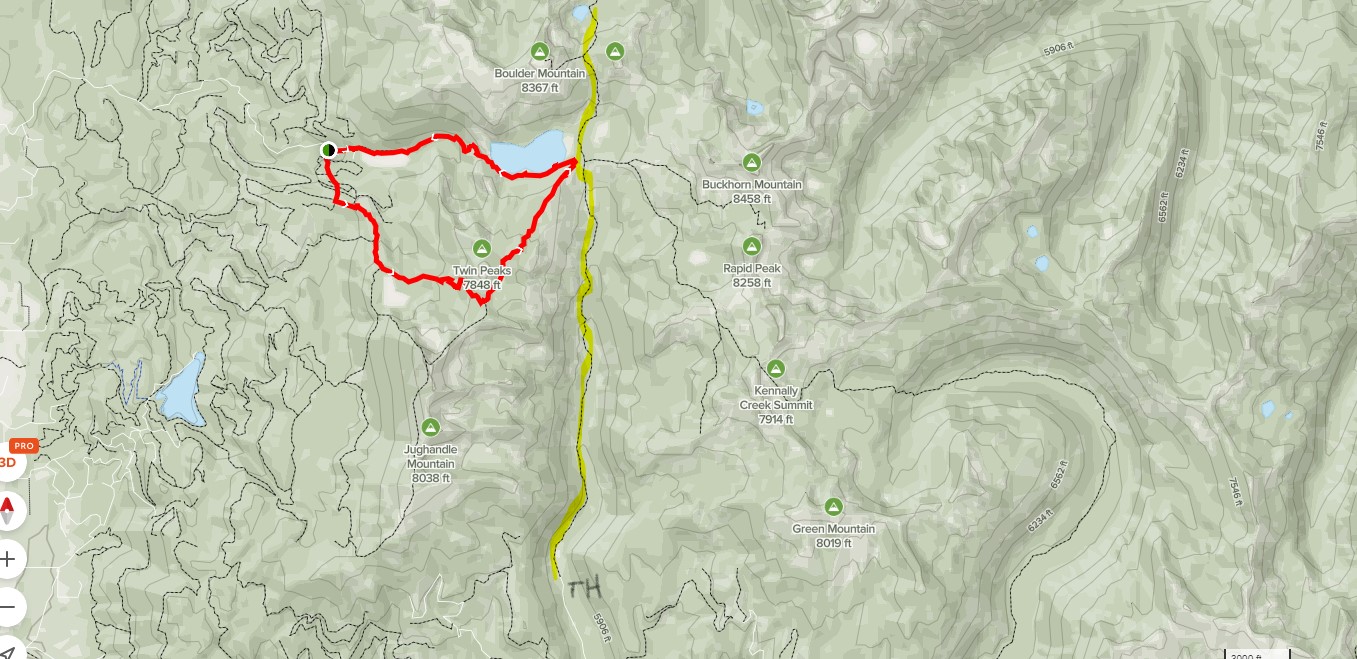
I hope you had a great father’s day weekend–the weather was amazing.
Tom asked me to send you some photos of our trail clearing activities up on the Rapid Creek Trail near Donnelly off of the Paddy Flat Road. Bart, Tom, Tracy Z and I did some much-needed overhead brushing for the first 5 miles of the trail north of the trailhead on Saturday and Sunday. Most of the trail was cut out but there are at least 3 or 4 short, wooden bridges over boggy spots that are rotting out badly, are uneven, broken, and are already dangerous for horses and hikers. The worst bridges are within the first 2 miles of the TH. We made it into Rapid Lake, Boulder Lake and Anderson Lake. The Rapid and Anderson Lake Trail spurs had some pretty serious logs that still need to be cut out (we did not take a chainsaw on that part of the trail). Trails are threading around those spots.
We also had some time for fun brook trout fishing at several of the lakes and Tracy Z played her new mini banjo one night and there was good food and salmon on the barbie.
We are looking forward to our Kennally Creek trip with you in a few weeks! Sharie

